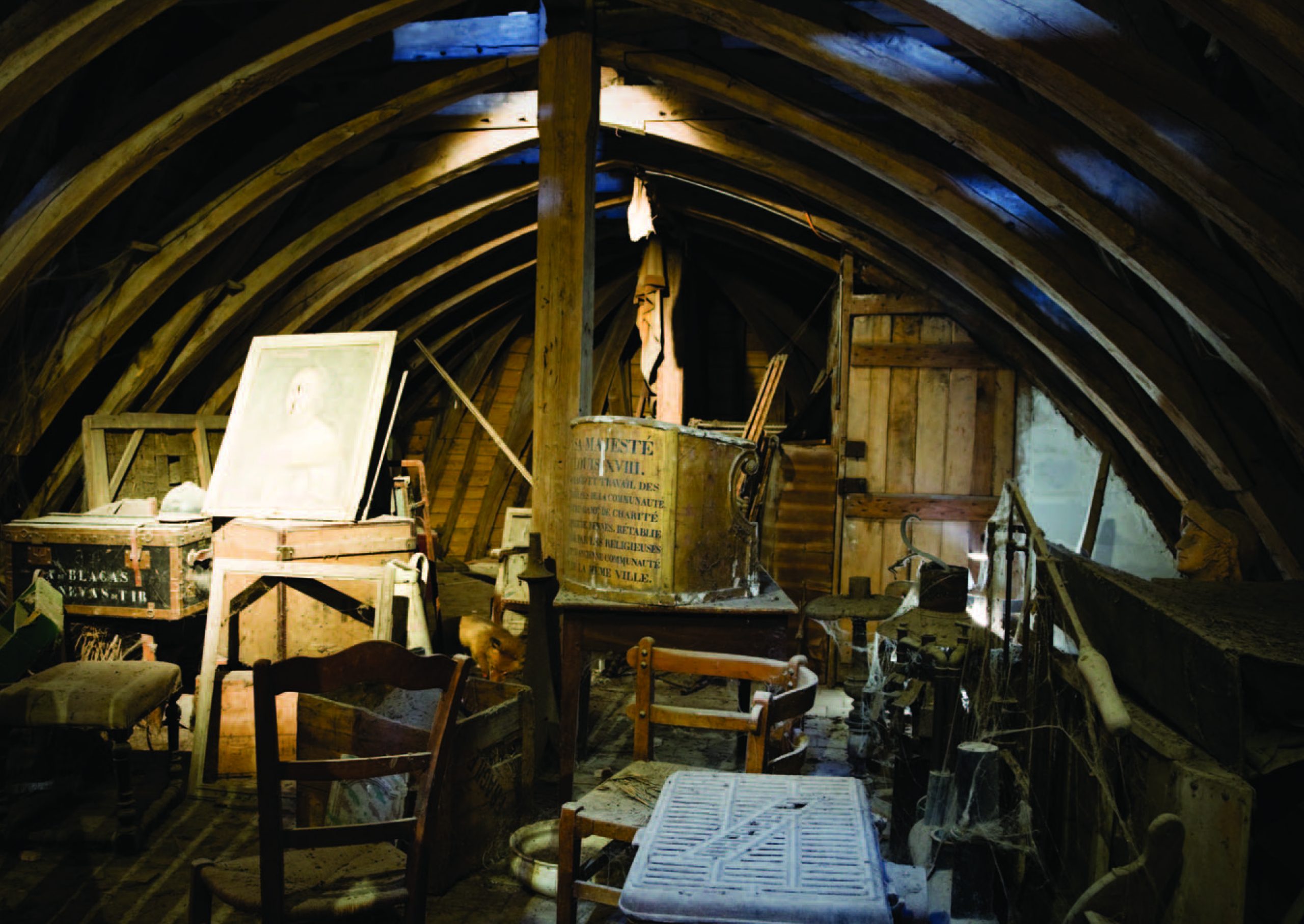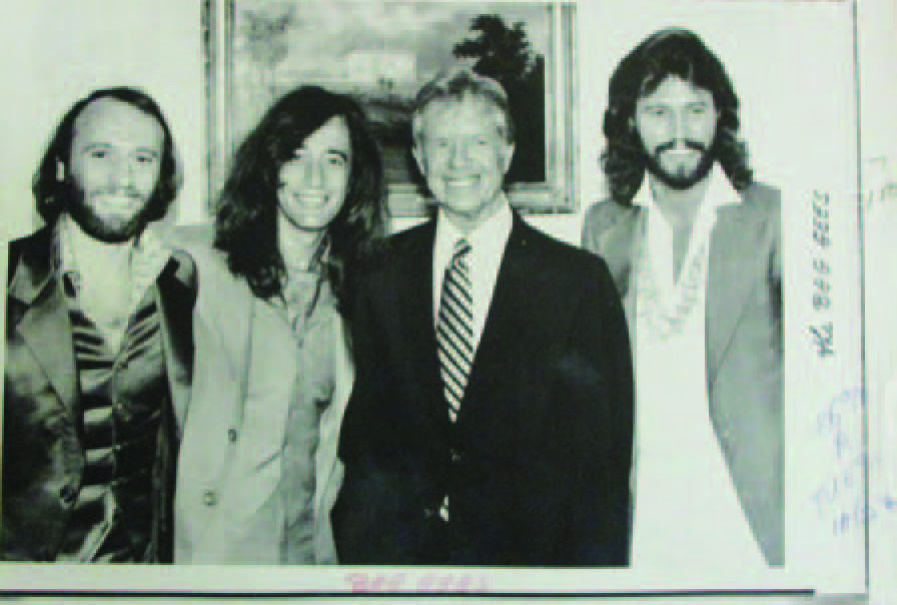When it comes to converting a dusty attic
into a dreamy live-work space, be prepared to deal with a dizzying number of variables.
Who among us hasn’t visited the house of a friend or relative, ascended into the attic and thought, Hey this could be a great extra floor? It’s fun to fantasize—to play architect, contractor and decorator—especially when it’s not your attic or your house or your bank account. Well, here we are in the new normal of the COVID-19 pandemic and its aftermath, with greater emphasis on telecommuting and remote-learning. Suddenly that unoccupied square footage is looking pretty tempting, isn’t it?

“Building up” is nothing new, of course. In fact, many newly constructed homes include unfinished attic space that can be easily converted into an office or an additional bedroom or two when the time comes.
However, for the vast majority of single-family dwellings in New Jersey, that is the exception, not the rule. When it’s your attic and your house and your bank account, there is a dizzying array of costs and considerations involved—and you pretty much have to get every one of them right.
HEAD SPACE
First and foremost, there needs to be enough room up there to accommodate the expansion. Understand, therefore, that looks can be deceiving. By the time a proper floor goes down and sheetrock goes up, much of that open, airy feel will be gone. Whether you are thinking of a home-office, an extra bedroom or two, a man-cave, a she-shed or some combination, you will almost certainly need at least 100 square feet of floor space, more than two-thirds of which has enough head room for a normal adult. Those minimums can be monkeyed with a little bit, but not too much, because every town in the Garden State has building codes covering this type of interior construction and—guess what?—you’ll need permits and an inspector to sign off on your work when it’s done.
Why all the fuss? One word: Fire. 
Unlike other rooms in your home, attic space is not only a potential deathtrap during a blaze (remember, fire travels up), but a high percentage of home fires in the U.S. begin in the attic, usually because of old or faulty wiring. A live-work conversion means you’ll be bringing lighting and electrical outlets into a space that may only have a couple of bare lightbulbs right now. That work must be done up to code and by a licensed and insured professional; it’s no job for a DIYer or your cousin who used to be an electrician. P.S. there’s probably a reason he used to be an electrician. Additionally, there must be an obvious egress in case someone is working or sleeping in the top floor. Attic stairways act like a chimney and are not always great escape routes. A window big enough to crawl out of is practically a given. A windowless attic redo is not impossible, but it is obviously problematic.
Lofty Ambitions
In years past, the pros and cons of converting attic space often depended on a three-variable calculation: What can I afford, what will it cost me and, most importantly, is it worth it? Say adding a live-work space comes with a price tag of $50,000. Many homeowners—concerned whether they would recoup that outlay, intimidated by the disruption of major construction and tempted by low interest rates—considered buying another house nearby with a bit more room.
In 2020, things got a bit more complicated. Housing prices in suburban New Jersey soared, office workers were told to stay home and children (school-age and in some cases adult kids) were suddenly underfoot, all due to pandemic restrictions.
In short, people in need of more space were more likely to stay put. The only problem, as mentioned earlier, is that your existing attic might not be big enough to become legal bedrooms. According to architect Bob Kellner, RA, NCARB, you might not be out of luck. Almost any “found” space, he points out, can become something usable—even fun and interesting—with a bit of creativity.

“Where a lack of height or overall space makes a third floor imprudent or non-compliant, consider a loft space,” he suggests. “If an existing attic allows—even if shallow in head height—it can often be accessed by a ladder instead of a staircase. You can make a sleeping loft or play area for older children or a cozy workspace. This can be done without adding expensive dormers, raising the roof or losing area on the floor below. It’s a what-can-we-do-with-what-we-have solution. And loft space is always best when it overlooks adjacent space where the ceiling has been removed so that area is ‘vaulted.’ People are looking for fun and interesting design these days—that is the case whether it adds to a realtor’s calculated living area or not.”
MOVING ON UP

Speaking of stairways, that can be a major expense when it comes to incorporating the attic into your home. Odds are, however you access your attic now will not be code-compliant. In most towns, you’ll need something at least three feet wide, with a specific rise and run, usually 10 inches high by 7 inches deep. This creates a couple of expensive problems. If your attic space is currently accessible through a crawl-space opening or pull-down stairs (which is the case in older single-story homes), then you are looking at 100% new construction. If you already have a staircase leading to your attic, grab your tape measure before you shout Yes! Some of those old attic steps are far too narrow to pass inspection. Also, adding or reconstructing a staircase to code may end up consuming precious hallway space on your current top floor. Truth be told, the cost and/or inconvenience of just getting up the attic kills the dream before it even gets on to the drawing board. How lucky those long-ago homeowners are who renovated their attics before the building codes tightened, and who are now grandfathered in.
The cost of a new staircase typically starts at around $3,000, but that is not necessarily your biggest “hidden” expense. Another costly fix is at the top end of the stairs, where the bones of the attic come into play. When you go up there and look around, do you see a lot of 2×4’s? If so, that’s not a good look. These days, building inspectors like to see 2×8’s, 2×10’s and 2×12’s. In newer homes, this shouldn’t be an issue. But if you own an older home, then you already know that it’s full of surprises.

The expensive surprise here is that the house may not have been originally constructed to bear a load beyond what it does right now. Even if you only intend to throw a spare bedroom up there, you need to know the difference between a “dead load” and a “living load.” A dead load is boxes and other junk that piles up in the attic. A living load is people moving around and shifting weight into different places as a consequence of normal working or living activities. A minimally supported attic and/or roof may not only require all new joists and other retrofitting, you may need to address what’s going on in the basement, too. It is rare that a new home office in the attic creates foundation issues, or issues on upper floors, but it is by no means unheard of.
That’s what structural engineers are for.
Even if all you have to do is bring in 2×12’s under the roof and 2×10’s under the floor—and are okay with the additional costs of labor and materials—you will lose an astonishing amount of space with these upgrades, which might end up being a deal-killer, especially if you’re only trying to pick up a couple of hundred square feet of live-work space.
RUNNING HOT AND COLD

At this point, if you’ve checked these boxes and are still determined to plow ahead, you’ll need to consider the most economical way to bring heating, cooling and ventilation to the renovated attic space. An HVAC professional should be able to give you an accurate assessment of the viability and cost of extending your current system to the new top story. Since you (or a previous owner) installed a system meant for the space you have now, it may lack the oomph to go up another floor. That means freezing-cold winters and, more likely, blistering-hot summers, which is not part of an acceptable live-work equation. You can certainly add another unit or upgrade your existing one (if it’s nearing the end of its lifespan), and add new ducts and vents. Or, depending on the space, you may be able to get away with a mini split system, which may run as little as $1,000 installed. Keep in mind that you could also need rafter venting to move air behind any insulation you install.
Oh yes. Insulation. You probably have some kind of insulation in the attic already. Don’t assume that it’s good to go and just sheetrock over it. Have it checked by a professional, or at least call the company that manufactured it and make sure that it is good for your new space, and that there are no reported problems. If your roof is uninsulated, get some advice on the right material from your contractor, or from the dealer if you plan to install it yourself. You’re likely to get a recommendation of batt insulation with a vapor-retardant facing. This can be a DIY project if you want to save a couple of bucks—just remember the vapor barrier faces outward between the joists. Finally, don’t forget about the insulation under the attic floor. Check it to see that it hasn’t compacted. Your insulation plan should also include high-quality windows and, ideally, energy-conserving thermal curtains.
UNDER FOOT
Where flooring is concerned, you have a lot of choices. While insulating qualities are a consideration, you want to avoid the mistake most people make in not considering noise-reduction. The more insulation you install and the thicker the subfloor, the less sound will transfer to the rooms below. Before you even get to that part, though, walk around on the current flooring in the attic. If it’s squeaking or making other noises that can be heard underneath, then you must figure out why and then fix the problem. A good subfloor also should be level and secure. Another consideration in flooring is quality.
Because even the best-insulated converted attic space experiences the most temperature fluctuations in the house, don’t go cheap on materials. Get something that won’t swell or shrink. And if you intend to put something heavy up there—say, a bank of bookcases filled with books—ask your contractor to evaluate whether the joists can handle the load without cracking the ceiling below.
The finishing touches to a renovated live-work attic space involve lighting and color choices. If the job is done up to code, it may not include overhead lighting, but it will have electrical outlets at predetermined intervals. The darker the space—and attics do tend to be darker than the rest of the house—the more up-lighting you should consider and the brighter and whiter your paint choices should be. If the space is your new home office, think about situating your desk or workspace near a window.
I haven’t delved into adding dormers or bathrooms to an attic renovation, which can run into the tens of thousands of dollars. But it does bring me to a final point. Just because you can convert your unused attic into a great, usable live-work space, it doesn’t mean that you should. If the work-arounds and custom carpentry start piling up, the cost might well exceed what the new space is worth. Indeed, as crazy as it sounds, it might even exceed the cost of ripping off the roof and just adding an addition story to your home, which almost always comes with a six-figure tab.
WHAT’S THE DAMAGE?
The cost of transforming your dusty attic into a dreamy live-work space does indeed depend on a dizzying number of variables, which is why contractors exist. A talented one brings a mix of objectivity, subjectivity, foresight and experience to a project like this—most or all of which a typical homeowner lacks. The size and age of a structure has an enormous impact on the budget, as does personal taste and flexibility with the “must-have’s.”
What you must have is the financial wherewithal and the patience to get the job done right the first time, which means safely and legally. Can you squeeze out a renovation for under $10,000? Yes…a modest, utilitarian one—and that’s assuming your karma somehow shifts into overdrive and everything on the job goes exactly right. The real number to get everything you want is likely to start more at $20,000 or $30,000 (double that if a small bathroom is part of the plan) and can skyrocket quickly from there, depending on quality, code-compliance and, let’s face it, dumb luck.
HOW DEEP IS YOUR LOVE?
Would you pay $800 for a vintage signed photo by the Bee Gees? Here’s a look at what’s for sale online…

1967 Panini trading card
$95.00
1976 MSG concert ticket stub
stub
$15.00
(you can lie and say you were there)
 1977 original press photo with Jimmy Carter
1977 original press photo with Jimmy Carter
$17.00
1977 Rolling Stone magazine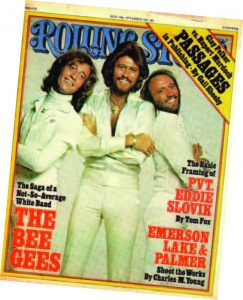
$25.00
(their iconic Saturday Night Fever pose)

1978 Andy Gibb poster box
$12.00
1978 Bee Gees lunch box
$75.00
(a little rusty, but aren’t we all?)
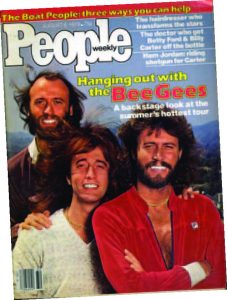 1979 People magazine
1979 People magazine
$10.00
1980 Ampex ad
$13.00
(with Jersey Girl Deborah Harry)
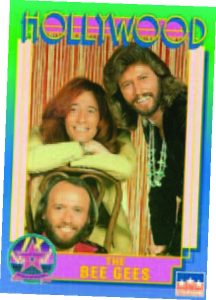 1991 Starline trading card
1991 Starline trading card
$4.00
Barry Gibb signed photo
$75.00
1980S Ampex promo pin
(nice job on the airbrushing)
1970S Robin Gibb matchbox
$10.00
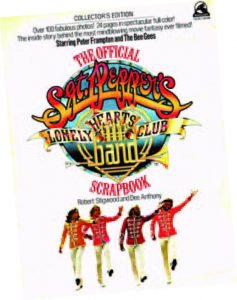 1978 Sgt. Pepper’s souvenir
1978 Sgt. Pepper’s souvenir
$30.00
1991 triple-signed promotional photo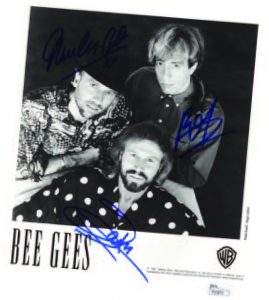
$799.00
EDGE takes you inside
the area’s most creative kitchens.
Grain & Cane Bar and Table • Miso Glazed Salmon
250 Connell Drive • BERKELEY HEIGHTS
(908) 897-1920 • grainandcane.com
 Our savory Miso Glazed Salmon—accompanied with jasmine shrimp, fried rice and an aromatic citrus yuzu coconut sauce—is one of many sensational seasonal menu items. Order online!
Our savory Miso Glazed Salmon—accompanied with jasmine shrimp, fried rice and an aromatic citrus yuzu coconut sauce—is one of many sensational seasonal menu items. Order online!
The Thirsty Turtle • Pork Tenderloin Special
1-7 South Avenue W. • CRANFORD
(908) 324-4140 • thirstyturtle.com
 Our food specials amaze! I work tirelessly to bring you the best weekly meat, fish and pasta specials. Follow us on social media to get all of the most current updates!
Our food specials amaze! I work tirelessly to bring you the best weekly meat, fish and pasta specials. Follow us on social media to get all of the most current updates!
— Chef Rich Crisonio
The Thirsty Turtle • Brownie Sundae
186 Columbia Turnpike • FLORHAM PARK
(973) 845-6300 • thirstyturtle.com
 Check out our awesome desserts brought to you by our committed staff. The variety amazes as does the taste!
Check out our awesome desserts brought to you by our committed staff. The variety amazes as does the taste!
— Chef Dennis Peralta
The Famished Frog • Mango Guac
18 Washington Street • MORRISTOWN (973) 540-9601 • famishedfrog.com
 Our refreshing Mango Guac is sure to bring the taste of the Southwest to Morristown.
Our refreshing Mango Guac is sure to bring the taste of the Southwest to Morristown.
— Chef Ken Raymond
Arirang Hibachi Steakhouse • Pork Belly Bao Buns
1230 Route 22 West • MOUNTAINSIDE
(908) 518-9733 • partyonthegrill.com
 Tender pork belly, hoisin sauce and pickled cucumber served on a Chinese bun.
Tender pork belly, hoisin sauce and pickled cucumber served on a Chinese bun.
LongHorn Steakhouse • Outlaw Ribeye
272 Route 22 West • SPRINGFIELD
(973) 315-2049 • longhornsteakhouse.com
 Join us for our “speedy affordable lunches” or dinner. We suggest you try our fresh, never frozen, 18 oz. bone-in Outlaw Ribeye—featuring juicy marbling that is perfectly seasoned and fire-grilled by our expert Grill Masters. Make sure to also try our amazing chicken and seafood dishes, as well.
Join us for our “speedy affordable lunches” or dinner. We suggest you try our fresh, never frozen, 18 oz. bone-in Outlaw Ribeye—featuring juicy marbling that is perfectly seasoned and fire-grilled by our expert Grill Masters. Make sure to also try our amazing chicken and seafood dishes, as well.
— Anthony Levy, Managing Partner
Ursino Steakhouse & Tavern • House Carved 16oz New York Strip Steak
1075 Morris Avenue • UNION
(908) 977-9699 • ursinosteakhouse.com
 Be it a sizzling filet in the steakhouse or our signature burger in the tavern upstairs, Ursino is sure to please the most selective palates. Our carefully composed menus feature fresh, seasonal ingredients and reflect the passion we put into each and every meal we serve.
Be it a sizzling filet in the steakhouse or our signature burger in the tavern upstairs, Ursino is sure to please the most selective palates. Our carefully composed menus feature fresh, seasonal ingredients and reflect the passion we put into each and every meal we serve.
Support Our Chefs!
The restaurants featured in this section are open for business and are serving customers in compliance with state regulations. Many have created special menus ideal for take-out, delivery or socially distant dining, so we encourage you to visit them online.
Do you have a story about a favorite restaurant going the extra mile during the pandemic? Post it on our Facebook page and we’ll make sure to share it with our readers!
Your favorite performers. Their best-ever live recordings.
Nothing beats seeing your favorite band perform live. That’s why live albums are almost always disappointing. There are, however, some spectacular exceptions. Over the years, a handful of special albums have captured the aura and energy of groundbreaking bands and musicians at their very best. These are some of our favorites…
 1963
1963
James Brown Live at the Apollo
Brown was so sure this would be a hit that he financed the recording himself. It is now in the Library of Congress National Recording Registry.
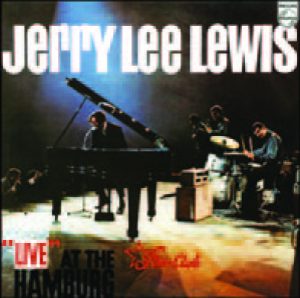 1964
1964
Jerry Lee Lewis Live at the Star Club, Hamburg
The one and only album that captures Jerry Lee’s explosive stage presence.
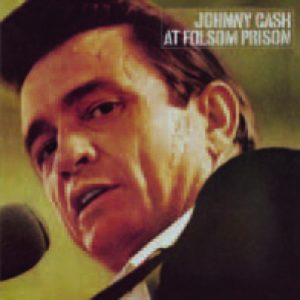 1968
1968
Johnny Cash
At Folsom Prison
This breakthrough live album, which revived Cash’s flagging career, combines two shows recorded at Folsom State Prison in California.
 1969
1969
Grateful Dead Live/Dead
No record really captures The Dead at their best, but this one—the first live album to use 16-track recording—comes the closest.
 1970
1970
Rolling Stones Get Yer Ya-Ya’s Out
Recorded almost entirely during two shows at the “new” Madison Square Garden and hailed as the best-ever live rock album at the time, it still more than holds its own.
 1970
1970
The Who
Live at Leeds
The only live album made by the band when its “big four” of Roger Daltrey, Pete Townshend, Keith Moon and John Entwhistle were together.
 1971
1971
Aretha Franklin Live at Fillmore West
Not surprisingly, the album shot to #1 on the R&B charts. Is that Billy Preston on the organ? Yes, it is!
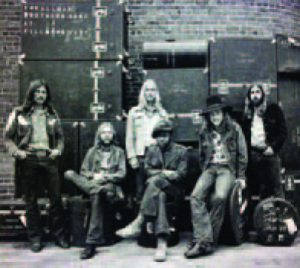 1971
1971
The Allman Brothers Band
At Fillmore East
The band’s breakthrough double-LP, which includes seven songs on four sides, was recorded at Bill Graham’s club in New York over the course of three nights.
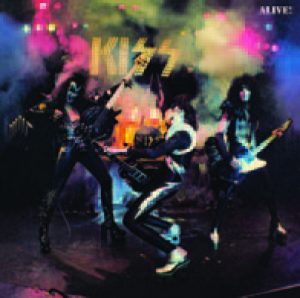 1975
1975
Kiss
Alive!
A classic example of a live album that took a popular band to a whole new level.
 1975
1975
Bob Marley
and the Wailers
Live!
Marley had a two-night gig in London and the crowd was so electric the first night that he decided to record the second.
The 1970s:
Heyday of the Live Album
Why so many ‘70s discs on the list? When Johnny Cash released his Folsom Prison album, it was an eye-opener for the record industry, which had mostly released unimaginative, low-quality live albums for its top stars as quick-hit moneymakers. Cash proved to his fellow musicians and their labels that a live album could be its own sensational work of art and soon everyone was investing in concert recordings. The technology of the 1970s was crude by modern standards, but there was enough engineering talent to clean up the background noise without losing the crackling energy of performers playing to their Joel Baldwin/Look Magazine adoring fans. By the early 1980s, however, live albums had fallen out of favor. MTV triggered a brief revival with its Unplugged series, but we may never see (or hear) albums like the ones we plucked out of the record store racks all those years ago.
its top stars as quick-hit moneymakers. Cash proved to his fellow musicians and their labels that a live album could be its own sensational work of art and soon everyone was investing in concert recordings. The technology of the 1970s was crude by modern standards, but there was enough engineering talent to clean up the background noise without losing the crackling energy of performers playing to their Joel Baldwin/Look Magazine adoring fans. By the early 1980s, however, live albums had fallen out of favor. MTV triggered a brief revival with its Unplugged series, but we may never see (or hear) albums like the ones we plucked out of the record store racks all those years ago.
 1975
1975
Earth, Wind & Fire Gratitude
A few non-live numbers are included, but here is EWF at the absolute height of its power.
 1976
1976
Peter Frampton Frampton Comes Alive!
The album dropped in January, beginning a long and remarkable climb to #1 four months later on the strengths of the singles “Show Me the Way,” “Do You Feel Like We Do” and “Baby, I Love Your Way.”
 1976
1976
Bob Seger & the Silver Bullet Band Live Bullet
A Detroit rock hero live in the Motor City, it features the indelible “Turn the Page.” Seger’s next album was Night Moves.
 1976
1976
Paul McCartney & Wings
Wings Over America
Criticized for months of clean-up work in the studio, but what a surprise when the long-awaited double-LP came out as a triple album!
Jazzy
Jazz aficionados are fond of arguing that the first truly great live albums were jazz recordings. And you know what? They’re right. Here are five of the best…
1956 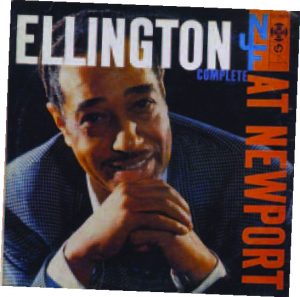
Duke Ellington At Newport
Arguably the finest live performance ever captured of The Duke.
1961 • Bill Evans
Sunday at the Village Vanguard
A great jazz trio firing on all cylinders.
1962 • John Coltrane
Live! At The Village Vanguard
Complex, textured and sometimes hard to follow, this was undoubtedly Coltrane’s most challenging album.
1995 • Miles Davis
The Complete Live at the Plugged Nickel, 1965
Herbie Hancock and Newark’s Wayne Shorter were part of the Davis quintet recorded at this Chicago nightclub.
1997 • Dizzy Gillespie
& Charlie Parker
Diz ‘n Bird at Carnegie Hall
A crisp recording of their famed 1947 concert in New York.
 1978
1978
Little Feat
Waiting for Columbus
Live albums are typically gifts to existing fans. This double-disc release created millions of new ones for Little Feat. Ironically, the band broke up a year later.
 1978
1978
The Band
The Last Waltz
This “farewell” album was recorded on Thanksgiving 1976 and featured a superstar lineup of guest performers, including Bob Dylan, Van Morrison, Eric Clapton, Neil Young and Joni Mitchell.
 1984
1984
Talking Heads Stop Making Sense
The movie is an absolute must-see. The soundtrack album is nearly as good.
 1985
1985
Sam Cooke
Live at the Harlem Square Club, 1963
Sam Cooke is captured in front of an African-American audience in Miami in a performance so gritty and powerful that it was feared it might ruin his crossover career at the time, and was shelved until long after his death.
 1986
1986
Jimi Hendrix
Jimi Plays Monterey
Much like Bruce and The Dead, no album really captures the ”live vibe” of Jimi Hendrix, but the Monterey concert comes tanta-lizingly close. Jimi blows the roof off of “Wild Thing” and then sets his guitar on fire.
 1986
1986
Bruce Springsteen & the E Street Band Live 1975–1985
The first album in a decade to debut at #1, Springsteen’s five-LP/3-CD set was so highly antici- pated that it pre-sold 1.5 million copies. Many record stores sold it right off the delivery truck the morning it arrived.
 1992
1992
Eric Clapton Unplugged
At 25 million copies and counting, this is the top-selling live album of all time. Clapton’s heartbreaking “Tears In Heaven” still makes his fans cry.
 1994
1994
Nirvana
MTV Unplugged
In New York
Nirvana fans were irked initially when they figured out that the band wasn’t playing a greatest hits set—and then watched Kurt Cobain & Dave Grohl knock it out of the park.
Frank and Judy
A pair of powerhouse talents at their best…
 1961
1961
Judy at Carnegie Hall
The apex of Judy Garland’s 1960s comeback, this double-album was #1 for months and has never once been out of print in six decades.
 1963
1963
Sinatra at the Sands
Frank in his natural habitat, Las Vegas, backed by Count Basie with arrangements by Quincy Jones.
 1994
1994
Eagles
Hell Freezes Over
The album takes its name from the answer to when the Eagles would get back together after splitting up in 1980. It instantly soared to the top of the charts and kicked off one of the most successful concert tours in history.
 2001
2001
Jay-Z
MTV Unplugged
Jay-Z at the height of his powers, backed up by The Roots. Hard to argue that this isn’t the best live rap album ever made.
 2016
2016
The Beatles
Live at the Hollywood Bowl
The original album, released in 1977, was pretty good. This is the re-mixed, re-mastered version you can actually hear over the shrieking teeny-boppers, and includes four previously unreleased songs.
 2018
2018
Bruce Springsteen The Roxy West Hollywood, CA
Recorded in 1975 as Born to Run was taking the nation by storm, this album features Bruce & Co. at their best in an intimate, non-stadium setting. Released by Springsteen himself.
Photo credits:
James Brown • King Records
Jerry Lee Lewis • Phillips Records
Johnny Cash • Columbia Records
Grateful Dead • Warner Bros. Records/Seven Arts
Rolling Stones • Decca/London Recordings
The Who • Decca/MCA Records
Aretha Franklin • Atlantic Records
Allman Brothers • Capricorn Records
Kiss • Casablanca Records
Bob Marley • Island Records
Earth, Wind & Fire • Columbia Records
Peter Frampton • A&M Records
Bob Seger • Capitol Records
Paul McCartney • Capitol Records
Duke Ellington • Capitol Records
Little Feat • Warner Bros. Records
The Band • Warner Bros. Records
Talking Heads • Sire Records
Sam Cooke • RCA Records
Jimi Hendrix • Reprise Records
Bruce Springsteen • Columbia Records
Eric Clapton • Reprise Records/MTV
Nirvana • DGC Records
Judy Garland • Capitol Records
Frank Sinatra • Reprise Records
Eagles • Geffen Records/Eagles Recording Co.
Jay-Z • Def Jam Recordings/Roc-A-Fella Records
Beatles • Universal Music Group/Apple Records
Eight incredible tales of wilderness survival.
Nothing is more terrifying than a wilderness survival situation. In one jolting moment, you are torn from safety and security and thrown into profound peril. You are alone, with little more than your wits and endurance keeping you alive. It’s the stuff of nightmares. And, of course, the stuff of movies and television. Think Tom Hanks in Cast Away. Or James Franco in 127 Hours. Or, if you’re a reality TV fan, Naked and Afraid. The theme of man- or woman-against-nature is as old as literature.
Older, in fact…hear me out.
I believe it’s a part of our basic biology. Think about it: We all are descended from at least one individual who found himself or herself alone in the wild, possibly left for dead, and then somehow beat the odds and made it back to safety. That little speck of DNA that survived along with that person has been passed down through a dozen or a hundred or a thousand generations—to me, to you, to all of us. Which is why our curiosity is triggered and our adrenaline begins to surge when we see or hear or read about someone who defies the odds and stumbles out of an impenetrable jungle or washes up on a distant shore.
One of the most enduring survival stories in the annals of popular fiction is Robinson Crusoe, the tale of a shipwrecked traveler who spends 28 years on a relentlessly hostile island somewhere in the Caribbean. The book was first published in 1719 and was an immediate sensation. Many readers believed it to be a real-life account and wondered how they might fare in similar circumstances. This was a new genre, “realistic fiction,” and author Daniel DeFoe had clearly tapped into that primal wiring all humans share. Although the plot details of Robinson Crusoe leaped from the fertile imagination of DeFoe, the inspiration for the title character almost certainly came from the incredible tale of Alexander Selkirk, our first of eight remarkable survival stories.
ALONE ON AN ISLAND
Selkirk was a 20-something Scottish privateer during the War of Spanish Succession, a conflict that embroiled all of Western Europe and its colonies in the early 1700s and helped England become a world economic power. Selkirk’s impulse control left much to be desired. He actually had chosen a life at sea over showing up in court to face charges of “indecent conduct in church.” In 1704, he was serving aboard the Cinque Ports in the Pacific, fighting French ships and plundering Spanish mining settlements in South America. When his captain, Thomas Stradling, overloaded the leaky ship on a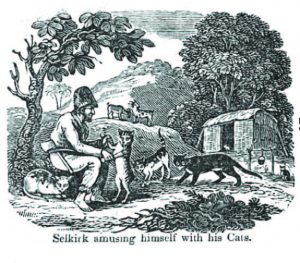 resupply stop in Mas a Terra, an uninhabited island off the coast of Chile, Selkirk insisted he would not sail unless much-needed repairs were made. Captain Stradling took the unruly Selkirk at his word and abandoned him on the island with a musket, hatchet, knife, cooking pot and Bible. The Cinque Ports sailed away…and soon sank.
resupply stop in Mas a Terra, an uninhabited island off the coast of Chile, Selkirk insisted he would not sail unless much-needed repairs were made. Captain Stradling took the unruly Selkirk at his word and abandoned him on the island with a musket, hatchet, knife, cooking pot and Bible. The Cinque Ports sailed away…and soon sank.
Selkirk set up camp on the beach, living off lobsters and waiting for another ship to sail by. His first of many rude awakenings came during mating season for thousands of sea lions, which chased him off the beach and into the island’s interior. There he lived off wild turnips and cabbage, as well as feral goats, when he could catch them. Unfortunately, Selkirk found himself plagued by rats, which attacked him every night after the sun went down. He solved this problem by using goat milk and meat to domesticate wild cats that lived on the island. They kept the rodent population at bay. Two ships did show up, but both were Spanish. One spotted him and sent ashore a landing party to capture him. Had they been successful, Selkirk would likely have been executed.
Four years and four months after being marooned, Selkirk was finally rescued by an English privateer and went back to his plundering ways like a man making up for lost time. Still an impetuous risk-taker, he was given command of his own ship and enjoyed several successful forays into Spanish territories. He made enough to retire comfortably in London, and his story made him something of a celebrity there, but soon Selkirk grew restless and he joined the Royal Navy, probably to avoid the long arm of the law or some other offended party. He lived an eventful life and was buried at sea after contracting yellow fever at the age of 45.
BEAR NECESSITIES
Another familiar story inspired by a real-life tale of survival is The Revenant, the 2015 film starring Leonardo DiCaprio. A “revenant” is someone who has been revived from death. Leo plays Hugh Glass, a frontiersman who, while serving on a westward expedition in 1823, was badly mauled by a grizzly bear in current-day South Dakota. He managed to kill the bear before losing consciousness, but suffered  what appeared to be mortal wounds. After dragging the unresponsive Glass on a litter two days, the expedition’s leader decided he was slowing down their progress and assigned two members of the party to stay with him until he died. While the two men waited for the inevitable, they dug a shallow grave. When the inevitable didn’t come quickly enough, they stripped Glass of his valuables and placed him in the hole they had dug. When the men caught up with the expedition they dutifully reported the sad news of their companion’s demise.
what appeared to be mortal wounds. After dragging the unresponsive Glass on a litter two days, the expedition’s leader decided he was slowing down their progress and assigned two members of the party to stay with him until he died. While the two men waited for the inevitable, they dug a shallow grave. When the inevitable didn’t come quickly enough, they stripped Glass of his valuables and placed him in the hole they had dug. When the men caught up with the expedition they dutifully reported the sad news of their companion’s demise.
You probably know the story. Glass awoke sometime later to find himself alone and under the skin of the bear that had attacked him—with a broken leg and deep, festering wounds. He set his own leg and allowed maggots to feast on his dying flesh in order to prevent gangrene. He survived on berries and roots. Glass dragged himself to the Cheyenne River, made a crude raft, and floated down to Fort Kiowa—a six-week journey covering 200 miles. After recovering from his injuries, Glass set out to exact murderous revenge on the two men who left him for dead.
Glass caught up with one of them, a teenager named Bridges, where the Bighorn River empties into the Yellowstone River. Seeing how young Bridges was, he decided to spare him. He found the second man, named Fitzgerald, in Nebraska. Fitzgerald had joined the army and was stationed at Fort Atkinson. Knowing he would be executed if he killed a U.S. soldier, Glass spared Fitzgerald, too, but warned him that he had better make the military a lifelong commitment—because the day he left the army he would end him. Glass never got the chance. He returned to frontier life and was killed during a skirmish with an Arikira war party. If you haven’t seen The Revenant, don’t worry about spoilers here; the movie is what they called a “fictionalized” version of the true story.
SNOWBOUND
Jan Baalsrud’s story sounds like it must be fiction. A Norwegian commando fighting for the resistance against Nazi occupiers during World War II, Balsruud and 11 compatriots set out to destroy an airfield control tower in the winter of 1943. Their mission was compromised when they mistook a local shopkeeper for their resistance contact (both men had the same name) and the shopkeeper—fearing he was being tested by the Germans—turned them in. The next morning, Baalsrud’s boat, which was loaded with 100 kilos of explosives, was sunk and everyone except Baalsrud was either killed or captured.
Baalsrud, soaking wet and missing one boot, hid in a snow gully, where he disarmed and shot a Gestapo officer with his own luger. From there, the Norwegian evaded capture for two months, surviving in frigid conditions with occasional assistance from locals. Suffering from snow blindness and frostbite, Baalsrud amputated his toes with a pocketknife to avoid gangrene.
Baalsrud hid from German patrols behind a snow wall for weeks and then was transported by stretcher to the Finnish border. Now near death, he was taken by a group of native Samis by reindeer to neutral Sweden. After months of recovery, Baalsrud made his way to Scotland, where he trained fellow Norwegian commandos. Eventually, he returned to Norway, where he worked as a secret agent until the end of the war. Baalsrud lived to the age of 71. At his request, his ashes were buried in the same grave with one of the partisans who had aided him during his escape from the Nazis in 1943, and paid the ultimate price.
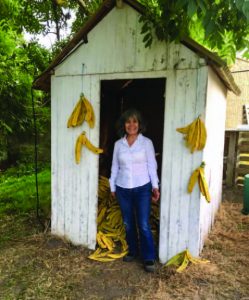
SOUNDS BANANAS
Staying alive in the wild often depends on one’s ability to take advantage of the local animals. Marina Chapman’s spin on this rule of wilderness survival is a jaw-dropper. Around 1960, she was abducted as a toddler and then left for dead deep in the Colombian rainforest when her kidnappers, possibly realizing that her family would be unable to afford a ransom payment, dumped her and drove away. She walked for days, hoping to find a village and crying for help that never came. What she found was a troop of capuchin monkeys, who eventually adopted her. She knew she had been accepted into the group when the monkeys urinated on her leg and, later, when they groomed her and allowed her to groom them. For as long as five years—Marina has no way to say for sure—she lived with the capuchins. During that time, she managed to decipher how they communicated and was able to produce a vocabulary of whistles, coos, chirps and high-pitched screams. She said all they (and she) thought about was what they would eat each day.
By the time Marina was “rescued” by a pair of hunters, she had forgotten how to speak. They sold her to a brothel, where she did housework but managed to escape before being forced into prostitution. She used her “monkey skills” to survive as a street urchin in the town of Cucata before being taken in by a family in Bogota around the age of 14. She decided to name herself Marina after a Colombian beauty queen and eventually went to England as the family’s nanny. She married an Englishman and had a family of her own.
Marina taught her children how to climb trees and liked to tell them bedtime stories about hunting for food in the jungle. Sometimes she’d walk around the yard on all fours. And she could spot a snake from hundreds of feet away. The kids thought she was just being funny until they were old enough to hear the whole story—which Marina struggled to tell because her brain still functioned in a non-linear way. Finally, they encouraged her to write a book, The Girl with No Name. Several publishers turned it down, refusing to believe it could be true. To this day, many doubt Marina’s story. True or not, it’s quite a tale.
FALL GIRL
A jungle survival adventure of an altogether different kind began on Christmas Eve 1971, two miles in the air, when a Lockheed Electra passenger plane was struck by lightning and broke apart, spilling its passenger into the angry sky. Seventeen-year-old Juliane Koepcke, the daughter of German parents working in Peru, was still strapped in her seat when it detached from the fuselage. Her mother, who was sitting beside her, disappeared as the entire row of seats plummeted to the earth.
Koepcke regained consciousness and soon realized she was the only crash survivor. Experts theorize that the row of seats acted as a parachute, perhaps catching an updraft and, in addition, that the jungle canopy must have broken her fall. Even so, she suffered a broken collarbone, deep gashes in an arm and leg, and facial trauma. Koepcke pocketed some candy she found at the crash site and then activated the wilderness skills she learned while growing up in the Peruvian jungle with her father, a biologist, and her mother, an ornithologist. Koepcke found a river and waded downstream in knee-deep water for 10 days before discovering a small boat. She poured gasoline over her wounds to sterilize them and then fell asleep in the vessel. She was discovered the following morning by a group of fishermen, who transported her to the nearest village. Koepcke was reunited with her father, who was stunned to see her alive. She then led the recovery team to the crash site.
Koepcke pocketed some candy she found at the crash site and then activated the wilderness skills she learned while growing up in the Peruvian jungle with her father, a biologist, and her mother, an ornithologist. Koepcke found a river and waded downstream in knee-deep water for 10 days before discovering a small boat. She poured gasoline over her wounds to sterilize them and then fell asleep in the vessel. She was discovered the following morning by a group of fishermen, who transported her to the nearest village. Koepcke was reunited with her father, who was stunned to see her alive. She then led the recovery team to the crash site.
Running on Empty
Have you ever asked your iPhone “Where am I?” If it’s a geography question (as opposed to a career or relationship question) you’ll get an accurate answer that even includes a map. Thanks to GPS and online tools like Waze, getting lost is no longer the terror-inducing situation it was just a generation ago. Mauro Prosperi might be reluctant to admit it, but he really could have used one of those apps. He was competing in the 1994 Marathon of the Sands, a multi-day endurance race across Morocco’s slice of the Sahara Desert when a sandstorm separated him from the pack and left him alone and disoriented. Prosperi thought he was catching up, but he was actually running into neighboring Algeria.
an accurate answer that even includes a map. Thanks to GPS and online tools like Waze, getting lost is no longer the terror-inducing situation it was just a generation ago. Mauro Prosperi might be reluctant to admit it, but he really could have used one of those apps. He was competing in the 1994 Marathon of the Sands, a multi-day endurance race across Morocco’s slice of the Sahara Desert when a sandstorm separated him from the pack and left him alone and disoriented. Prosperi thought he was catching up, but he was actually running into neighboring Algeria.
Out of water and realizing the magnitude of his error, Prosperi grew despondent and attempted to slit his wrists. However, he was so dehydrated that the blood clotted almost instantly. Then he recalled a bit of advice a Berber nomad had offered before the race: When in doubt, walk in the direction of the morning clouds. And so, he set off again. Eating lizards, bugs and cacti, Prosperi made it to a desert oasis and was rescued, 40 pounds lighter than when he had started nine days earlier. He had run, walked and crawled 300 kilometers in the wrong direction.
In 1998, Werner Herzog made the film Wings of Hope, based on Koepcke’s remarkable story. It was a very personal project for the famed director. In 1971, he had been scouting locations in South America and was booked on Koepcke’s ill-fated flight…but missed it due to a last-minute change in his schedule.
WHALE OF A TALE
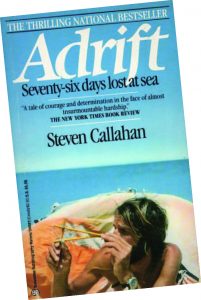 Just because you can build a boat, it doesn’t mean you should be sailing it by yourself. Steve Callahan, a naval architect and avid sailor, designed and constructed the Napoleon Solo and sailed it across the Atlantic to England in 1981. So far so good. From the port of Penzance, at the extreme southwest tip of England, he joined a single-handed sailing race to Antigua in January 1982. Foul weather off the coast of Spain swamped many of the entries, including the Napoleon Solo, but Callahan made repairs and, though he was now out of the running, decided to complete the journey anyway. One week later, the vessel’s hull was punctured during a night storm in a collision with a whale. Callahan had time to collect a few items, including the book Sea Survival, by Dougal Robertson. He climbed into a six-person life raft and watched his foundering ship drift away.
Just because you can build a boat, it doesn’t mean you should be sailing it by yourself. Steve Callahan, a naval architect and avid sailor, designed and constructed the Napoleon Solo and sailed it across the Atlantic to England in 1981. So far so good. From the port of Penzance, at the extreme southwest tip of England, he joined a single-handed sailing race to Antigua in January 1982. Foul weather off the coast of Spain swamped many of the entries, including the Napoleon Solo, but Callahan made repairs and, though he was now out of the running, decided to complete the journey anyway. One week later, the vessel’s hull was punctured during a night storm in a collision with a whale. Callahan had time to collect a few items, including the book Sea Survival, by Dougal Robertson. He climbed into a six-person life raft and watched his foundering ship drift away.
Callahan’s first move was to activate the raft’s E-PIRB (Electronic Position Indicating Radio Beacon). In 2021, this would lead to a quick rescue. But in 1982, satellites did not monitor E-PIRB signals, and the raft was in the “fat” part of the Atlantic that commercial airliners did not use, so no one else was close enough to detect the E-PIRB. As days turned into weeks, Callahan put Robertson’s words into action. He noticed that a kind of ecosystem developed around his raft and was able to spear or hook a variety of fish. He also created a sun still and other improvised devices that produced a pint of water a day. Callahan fended off sharks, repaired punctures, lost a third of his bodyweight and endured painful saltwater sores for 76 days before drifting to the coast of Guadeloupe.
the raft was in the “fat” part of the Atlantic that commercial airliners did not use, so no one else was close enough to detect the E-PIRB. As days turned into weeks, Callahan put Robertson’s words into action. He noticed that a kind of ecosystem developed around his raft and was able to spear or hook a variety of fish. He also created a sun still and other improvised devices that produced a pint of water a day. Callahan fended off sharks, repaired punctures, lost a third of his bodyweight and endured painful saltwater sores for 76 days before drifting to the coast of Guadeloupe.
After his ordeal, Callahan became a regular contributor to sailing magazines and also designed a lifeboat based on his survival experience. Callahan also wrote the novels Adrift and Capsized. During the making of the 2012 film Life of Pi, director Ang Lee hired Callahan as a consultant to make life aboard a drifting lifeboat more realistic. Callahan fashioned the various fishing lures and other tools that were used by Suraj Sharma throughout the movie.
A FISHY STORY
Callahan called the open ocean the world’s great wilderness. He gets no argument from Jose Alvarenga. An experienced Pacific fisherman, he set out from Costa Azul in Mexico on November 17, 2012 in a 23-foot fiberglass skiff with a big icebox and single outboard motor. His usual fishing partner was unavailable, so he took on a young, inexperienced assistant named Ezequiel Cordoba, whom he had never met before. The two men brought in 1,000 pounds of fish the first day, but a sudden storm prevented them from returning to port. For five straight days, the storm blew them ever deeper into the ocean, destroying the boat’s motor and electronics, and causing them to lose all of their fishing equipment. They had to dump their heavy catch when the vessel became impossible to maneuver.
Fortunately, Alvarenga had managed to transmit a distress signal to the boat’s owner before going radio silent. Unfortunately, the ensuing search effort turned up nothing and was called off after two days. Alvarenga and Cordoba survived by catching fish and seabirds with their hands. After four months with no sign of rescue, apparently Cordoba gave up. He refused to eat and, after securing a promise from Alvarenga not to eat him, he slipped away and Alvarenga dumped his body over the side. Over the next nine-plus months, Alvarenga spotted several container ships in the distance but was unable to attract their attention. On January 30, 2014, he saw a speck of land on the horizon—it was a remote corner of the Marshall Islands, more than 5,500 miles from where he had started. When Alvarenga drifted close enough, he leaped out of the boat and swam to shore. Two locals encountered him on the beach naked and waving a knife, barely able to stand and screaming in Spanish.
At first, no one believed Alvarenga’s story. It seemed implausible that he could have survived 14 months on the open sea; no one had ever survived more than a year under those conditions. Scurvy should have killed him, or so the thinking went. However, the vitamin C he got from the birds and turtles he ate probably saved him. Various ocean scientists studied Alvarenga’s claims and looked at the meandering mid-Pacific currents. They not only determined that such a trip was plausible, but that he was fortunate to have made it as quickly as he did. Alvarenga later passed a polygraph test, ending any lingering doubts. You may recall seeing Alvarenga on television. For a few news cycles back in those innocent days of 2014, he was the lead story. Later, Alvarenga gave a series of interviews to investigative journalist Jonathan Franklin, who published 438 Days: An Extraordinary True Story of Survival at Sea. Finally, and perhaps predictably, Ezekiel Cordoba’s family then sued him for cannibalism.
There are really important lessons to be learned from each of these remarkable tales of survival. If you’d like to know what they are, ask someone else. Or pick up a copy of Field & Stream or Soldier of Fortune. Not being an outdoorsman myself, I have no idea what they are—with the obvious exception of “If you’re thinking about doing something risky beyond the reach of civilization…don’t.”
Did You Know??
Survival stories generate important information about how humans do without food and water. An individual in good health can last a week without food and water before vital organs completely shut down, assuming physical activity is kept to a minimum. Without food, the body needs about 1.5 liters of water (plus a teaspoon of salt) a day to maintain fluid levels. Unfortunately, we know this from hunger strikes.
My stronger, more adventurous camping cousin, who had to get himself to a hospital following a surprisingly serious fly-fishing injury, would no doubt correct me. He’d say, “Aw, go ahead and do it…just do it with someone else.”
That’s fine, I guess, as long as that someone else isn’t me.
Artists have endeavored to capture the depth and beauty of the great outdoors since brush first touched canvas. The work of Vincent Nardone is a personal invitation to his artistic vision of nature through context and color—and to join him on playful trips to the shorelines and waterways he loves.

Sunset Illusion, 2004 Acrylics on board, 24” x 30”
Aqua Beat, 2005
Acrylics on board, 18” x 24”
 Inlet Meltdown, 2006 Acrylics on board, 24” x 30” Private Collector
Inlet Meltdown, 2006 Acrylics on board, 24” x 30” Private Collector

Rhythms on the Manasquan, 2010 Acrylics on board, 25” x 31”
Private Collector
 Nature’s Pride, 2011
Nature’s Pride, 2011
Pastels, 20” x 30”
Permanent Collection of the Butler Institute of American Art, Youngstown, OH
 Back Bay Whimsy, 2013
Back Bay Whimsy, 2013
Pastels, 20” x 28”
Gold Medal of Honor in Pastels 2017, Audubon Artists Inc.
 Storm Brewing on the Barnegat, 2017 Encaustic on metal, 11” x 14”
Storm Brewing on the Barnegat, 2017 Encaustic on metal, 11” x 14”
 Shore Energy, 2019
Shore Energy, 2019
Pastels, 18” x 24”
Gold Medal of Honor in Pastels, Audubon Artists Inc. 2020
About the Artist
 All you need is an eye for fun and an ageless spirit to appreciate the work of internationally known artist Vincent Nardone of Brick Township, who describes himself as a Visionary Expressionist. His art reflects the rhythms and patterns of New Jersey back bays and coastlines. Says Nardone, “My creative process is a textural journey synthesized into bits and then abstracted into imagery using pastels, watercolor, mixed media, and acrylic impasto. I like to work on location with my palette knife, brushes, and ideas.” Many of his works seem to dance like sugarplum fairies along the waterways he often describes as “whimsy.” A South Orange native, Nardone recalls, “My mother wanted me to be a priest, but I wanted to be an artist and go out with girls.” He studied at the Newark School of Fine and Industrial Arts, Montclair State University, USC, and did annual post-graduate work in Paris and Florence. He taught in the South Orange-Maplewood school system for 30 years. He also won major awards, including Le Salon, Paris; Prix Rubens Medal; gold medals from the Audubon Artists, and other major awards from Allied Artists of America. All “sugarplums,” too.
All you need is an eye for fun and an ageless spirit to appreciate the work of internationally known artist Vincent Nardone of Brick Township, who describes himself as a Visionary Expressionist. His art reflects the rhythms and patterns of New Jersey back bays and coastlines. Says Nardone, “My creative process is a textural journey synthesized into bits and then abstracted into imagery using pastels, watercolor, mixed media, and acrylic impasto. I like to work on location with my palette knife, brushes, and ideas.” Many of his works seem to dance like sugarplum fairies along the waterways he often describes as “whimsy.” A South Orange native, Nardone recalls, “My mother wanted me to be a priest, but I wanted to be an artist and go out with girls.” He studied at the Newark School of Fine and Industrial Arts, Montclair State University, USC, and did annual post-graduate work in Paris and Florence. He taught in the South Orange-Maplewood school system for 30 years. He also won major awards, including Le Salon, Paris; Prix Rubens Medal; gold medals from the Audubon Artists, and other major awards from Allied Artists of America. All “sugarplums,” too.
Trinitas is primed to face the tsunami of mental health challenges created by COVID-19.
Long after we are clear of COVID-19, the fallout from the pandemic is likely to impact us for a lifetime. Exactly what the scope of those after-effects will be is difficult to say. However, healthcare systems are dealing with many of them now, including a dramatic uptick in mental health issues. It’s no surprise. Prior to the past year, tens of millions of people across the U.S. were already struggling with mood disorders, with only about half likely to seek professional treatment—a sobering assessment that comes from the National Institute of Mental Health. The deluge of negative news and emotional triggers (much of it delivered on the devices that were keeping us connected) has only made this situation worse.
There is a silver lining in this dark cloud.
Our obsessive connectivity has created greater awareness about what mood disorders are and knowing when and where to seek help. Thanks to expanded public education campaigns and a culture of sharing on social media, more people are willing to speak up and self-advocate when they realize their emotional state involves more than just these occasional experiences. Also, it appears that people have a better understanding that occasional bouts of sadness, anxiety and stress are normal, even healthy.
For more than five decades, Trinitas has filled that role, offering care and support for those suffering from mood disorders. Now, a comprehensive expansion—including a $5 million investment in its facilities and treatment programs—has made two new options available: esketamine and unilateral Electroconvulsive therapy (ECT). Along with the financial and material invest-ments, the introduction of these services complements an advanced, future-focused rethinking of how mood disorders are evaluated and treated.
Mood disorders, which distort an individual’s emotional state and can affect his or her ability to carry on a normal life, can include any impairment that leaves a person feeling unusually sad, depressed, or anxious. Manic conditions, in which a person’s mood quickly alternates between extreme depression and excessive happiness, also fall under this heading. At Trinitas, each patient’s care is tailored to his or her particular symptoms, history and lifestyle, according to Dr. James McCreath, Vice President of Behavioral Health. “Our approach to delivering treatment to our patients always centers on what’s most suitable for the individual,” he says. “Introducing new options this year allows us to further tailor our treatments.”
Redefining the Evidence Base
 Part of the shifting treatment landscape for Behavioral Health stems from what Dr. Salvatore Savatta, Chair of Psychiatry at Trinitas, calls a “dramatic expansion” over the last 15 years in relevant research and the volume of information sources from which practitioners can draw:
Part of the shifting treatment landscape for Behavioral Health stems from what Dr. Salvatore Savatta, Chair of Psychiatry at Trinitas, calls a “dramatic expansion” over the last 15 years in relevant research and the volume of information sources from which practitioners can draw:
“The ‘evidence base’ of ‘evidence-based medicine’ in psychiatry is profoundly deeper than it used to be. Twenty years ago, physicians typically treated patients in accordance with their own institutional preference, residency training, and personal experience. The available peer-reviewed evidence was extremely weak. Now, however, there is a relevant evidence base for almost every question a physician faces.”
Personalized treatment programs combine evidence-based psychotherapies with psychiatric medications; adding esketamine and unilateral ECT gives the team a fuller range of options. Esketamine, delivered as a nasal spray, is beneficial to patients with more challenging forms of depression. The unilateral ultra-brief pulse delivery of ECT now in use at Trinitas has been shown to be nearly as effective as the previous bi-lateral approach, and with far fewer side-effects. Both of these treatments can be considered when a patient fails to respond to more traditional antidepressants—promising brighter outcomes for patients at one of New Jersey’s largest hospital-based mood disorder programs.
Dr. Salvatore Savatta, Chair of Psychiatry at Trinitas, points out how important it is for people to consider all available options—including ECT—when undergoing treatment for severe mood disorders.
“There are many misconceptions about how today’s ECT affects the mind, even what this treatment looks like,” he says. “People base it on what they’ve heard or seen on TV and in the movies. And even those depictions of old-fashioned ECT treatments were largely inaccurate. We need to remove the stigma surrounding this treatment so more people can feel comfortable seeking out and receiving the help they need.”
In addition to improved methods for delivering ECT, the field of behavioral health has seen seismic changes in the way patients are evaluated and treated. According to Dr. McCreath, who brings 45 years of experience to his role, psychotherapy treatments have improved dramatically in both the number of options available and the effectiveness of those options. He also points out that, as a society, we’ve become more comfortable talking about mental illness— a key point in expanding access to treatment.
Quicker, Stronger
 Esketamine is a more potent and faster-acting form of ketamine, which is most often used as a surgical anesthetic and has been around for 50 years. Esketamine has an immediate effect on treatment-resistant depression and also appears to reduce suicide ideation. Delivering the drug in a nasal spray means it is absorbed by a different receptor than pills are—providing a much faster route to the brain, where it targets multiple brain connections at once.
Esketamine is a more potent and faster-acting form of ketamine, which is most often used as a surgical anesthetic and has been around for 50 years. Esketamine has an immediate effect on treatment-resistant depression and also appears to reduce suicide ideation. Delivering the drug in a nasal spray means it is absorbed by a different receptor than pills are—providing a much faster route to the brain, where it targets multiple brain connections at once.
“People struggling with mental illness—be it major depressive disorder, bipolar disorder, seasonal affective disorder, generalized anxiety, or any other disorder—now see it as acceptable, and are encouraged to talk about what they’re experiencing and to seek professional help earlier in their journey,” he says. “There’s a greater willingness to get treatment and they find larger, more impactful support networks among their friends and loved ones.”
McCreath also cites a greater emphasis in recent years on short-term treatment versus long-term hospitalization, along with a societal recognition that having a mental illness isn’t an impediment to enjoying a productive life.
The Trinitas Department of Behavioral Health and Psychiatry provides treatment to patients of all ages, as well as family services. The center offers a 98-bed inpatient facility and a specialized unit for adults with mental or developmental disabilities. Prior to the pandemic, Trinitas logged more than 15,000 outpatient visits a month. The team of practitioners includes psychiatrists, psychologists, social workers, substance abuse counselors, creative arts therapists and many others. Specialized services include parenting groups, women’s services, geropsychiatry, an adolescent residential program, and programs for individuals with HIV. Survivors of domestic violence and sexual abuse can also receive specialized care, as can juvenile offenders or persons requiring justice-involved services.
“People who come to Trinitas for behavioral health treatment will find a vibrant, young, and experienced team of forward-thinking providers who have all of today’s treatment options at the ready,” Dr. Savatta says. “We strive to show compassion at all times to our patients, and to their families.”
Considered individually, psychotherapies, medications, and technological advancements in fields like ECT offer promise to the millions across the country suffering from mental illness. The holistic approach in practice at Trinitas—in combination with the team’s skill, experience and humanity—provides relief and hope that no technology in itself can offer. Whatever the post-COVID landscape looks like, the Department of Behavioral Health and Psychiatry will be ready to respond.
Editor’s Note: For more information on behavioral health services at Trinitas, call (908) 994-7556.
Trinitas welcomes a familiar face to the nursing staff.
Barack Obama famously said that he was just starting to figure out who he was sometime in the 10th grade. Jasmine Jones has the 44th president beaten by two years. As an 8th grader, Jones decided to take the first step on a path that would lead her to the highest levels of the healthcare field when she devoted a good chunk of her summer to volunteering at Trinitas. In 2020, Jasmine Jones returned as a nurse in the hospital’s Emergency Department—at a time of profoundly critical need. It was a homecoming in more ways than one; the connection to Trinitas has been a near constant in her life.
 During her high school years at Union County Vo-Tech’s Allied Health School, Jones took part in a Medical Mentoring program and Nursing Camp at Trinitas, laying the foundation of skills and academics on which she built her professional plans. Her undergraduate studies at Drexel University—funded partly by a scholarship from Trinitas—propelled her ever forward and enhanced her passion for the business of healthcare.
During her high school years at Union County Vo-Tech’s Allied Health School, Jones took part in a Medical Mentoring program and Nursing Camp at Trinitas, laying the foundation of skills and academics on which she built her professional plans. Her undergraduate studies at Drexel University—funded partly by a scholarship from Trinitas—propelled her ever forward and enhanced her passion for the business of healthcare.
As an Emergency Department nurse at Trinitas, Jones enters the field at a time unlike any we’ve seen before, when a global pandemic has claimed hundreds of thousands of lives and placed healthcare workers at considerable risk. Yet like those who have come before her, she puts the lives of her patients first as she follows the path she began carving out almost a decade ago.
“The calling is greater than me as an individual,” she explains. “Nurses are like firefighters—we run toward a fire. There are so many incredible nurses here at Trinitas, and I’m just hoping to be half as good as them.”
While finishing her Bachelor of Science degree in Nursing at Drexel (she graduated in June, with a minor in Journalism), Jones worked as a Certified Nursing Assistant. She applied to Trinitas after graduation, received a job offer in August, and joined the Emergency Nurse Residency Program on September 14. As an 8th grader, she recalls, her time spent volunteering at “7 South” in Telemetry sparked this dream. Jones found further inspiration in her parents, both of whom worked in healthcare-related industries: her mother in insurance, her father in pharmaceuticals.
“The experience I gained at Trinitas was invaluable,” Jones says. “I helped make patients’ beds and performed tasks like bringing them water to make sure they were comfortable. It was eye-opening for me at that young age, and it cemented my belief that I had found my calling.”
One patient in particular stands out during that experience—a woman who spoke little English, and with whom Jones could communicate in basic Spanish.
“She called me enfermera, which is Spanish for ‘nurse,’ and I tried to explain that I was just una voluntaria,’” she says. “She kept calling me ‘nurse’ anyway, because she saw compassion in me–something that is so core to nursing, but also something you can’t teach. She was what truly inspired me to pursue a nursing career.”
Jones’s undergraduate experience at Drexel was also a game-changer.
“For a goal-oriented person like me, I knew Drexel would set me up for success and provide some amazing opportunities,” she says. “For example, I had the chance to study abroad in Australia and learn about how another country carries out its healthcare system.”
 That experience planted another seed for Jasmine Jones: the possibility of one day putting her journalism skills to use by traveling the world, tracking her experiences in a memoir, and using her expertise to impact healthcare policy. At the moment, as one of Trinitas’s promising new Emergency Department RNs, she’ll remain close to home and family. Her own, as well as the Trinitas family…which she’s been a part of now going on ten years.
That experience planted another seed for Jasmine Jones: the possibility of one day putting her journalism skills to use by traveling the world, tracking her experiences in a memoir, and using her expertise to impact healthcare policy. At the moment, as one of Trinitas’s promising new Emergency Department RNs, she’ll remain close to home and family. Her own, as well as the Trinitas family…which she’s been a part of now going on ten years.
DID YOU KNOW?
The World Health Organization proclaimed 2020 “Year of the Nurse and Midwife.” Little did they know! There are about four million registered nurses in the U.S., with more than half over the age of 50. Male RN’s make up between 9 and 10% of the nursing population. About 18% of nurses hold a graduate-level degree (an MSN, for example). More than half of U.S. nurses work in hospitals.
With each 9-1-1 call, two award-winning Trinitas teams spring into action.
Terror. Pain. Confusion. A swirl of sounds and people. The fear that this might be a one-way trip. This is the part of a cardiac emergency you don’t see on TV medical dramas. Yet it is in these first moments when help arrives that difference-making action begins. The target window of time during which an individual in this situation needs to receive emergency care is 90 minutes—so says the American Heart Association. Which is why the right call is a 9-1-1 call. Indeed, according to Gerard “Rod” Muench, Trinitas Regional Medical Center  Administrative Director of the Emergency and Emergency Medical Services Departments, a good chunk of that critical window can be wasted by driving that individual to the hospital in a personal vehicle. Dialing 9-1-1 initiates a System of Care that makes the most of those precious minutes.
Administrative Director of the Emergency and Emergency Medical Services Departments, a good chunk of that critical window can be wasted by driving that individual to the hospital in a personal vehicle. Dialing 9-1-1 initiates a System of Care that makes the most of those precious minutes.
Trinitas has been the recipient of Mission: Lifeline awards from the American Heart Association in each of the last four years. The departments receiving this honor are under the director- ship of Muench and Kathleen Azzarello, head of Cardiovascular Services—two professionals who excel at administering critical emergency-treatment response. Muench’s team is focused on saving the lives of severely distressed cardiac (and other) patients by streamlining the trip of EMS personnel from point of contact to the Emergency Department at Trinitas. Azzarello’s team, which includes the cardiac catheterization lab, is at the receiving end when the ambulance arrives with patients in cardiac distress.
Muench and his team deliver approximately 1,000 patients each year to Azzarello and her staff. On average, their coordinated care probably saves 50 patients a year—about one a week—whose extreme coronary distress would have resulted in death under almost any other scenario.
The Three C’s
The common goal of emergency System of Care protocols can be defined by three important C’s: Cooperation, Collaboration and Communication. The goal of the EMS team is to administer treatment at the very first moment that the EMTs make contact with the patient. Trinitas pre-hospital personnel is trained in procedures such as administering CPR, providing medication, inserting an IV, and transmitting an EKG to the hospital prior to the patient’s arrival. Once delivered to the Emergency Department, no time is wasted in turning over those in need of immediate cardiac care to the Cardiovascular Services Department.
at the very first moment that the EMTs make contact with the patient. Trinitas pre-hospital personnel is trained in procedures such as administering CPR, providing medication, inserting an IV, and transmitting an EKG to the hospital prior to the patient’s arrival. Once delivered to the Emergency Department, no time is wasted in turning over those in need of immediate cardiac care to the Cardiovascular Services Department.
The overall success of response to cardiac emergencies starts with expediting what used to be called “door-to-needle” time. The clock starts ticking at the point of first medical contact—in the home, in the car, at work, or on the phone with a 911 dispatcher—and doesn’t stop until a patient is transported by an emergency vehicle to the catheterization lab or cardiovascular department, where life-saving treatment can be initiated before time runs out. At Trinitas, first contact typically goes through the hospital’s Mobile Intensive Care Unit. The MICU operates in coordination with the Elizabeth Fire Department, which initiates on-site stabilization and treatment.
Everyone trained and supervised by Rod Muench appreciates that every minute matters when it comes to coronary patient outcomes, making the MICU an “Emergency Dept. on wheels.” He has been at Trinitas for 11 years, previously served as ED/EMS Administrator, and is often described as a paramedic educator. He has developed and implemented a thorough regimen for the hospital’s staff of EMTs, including a first-contact philosophy.
“Learning how to communicate with the patient is key,” Muench explains. “Good people skills are essential to a good emergency medical technician.”
The need to combine empathy with speed and accuracy is echoed by Kathleen Azzarello and her team, which deals with extreme pressure 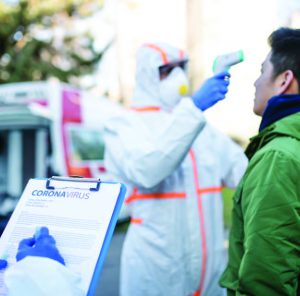 situations on a round-the-clock basis. In assembling that team, she looks for individuals who are “a bit of an adrenaline junkie,” adding that they need to stay calm under fire and also appreciate the ultimate rewards of being a critical caregiver. What is her reward?
situations on a round-the-clock basis. In assembling that team, she looks for individuals who are “a bit of an adrenaline junkie,” adding that they need to stay calm under fire and also appreciate the ultimate rewards of being a critical caregiver. What is her reward?
“It’s an amazing privilege to watch a cardiac patient go from near death upon arrival to wanting to leave the hospital as soon as treatment has been administered.”
Needless to say, COVID-19 has complicated the work of everyone involved in emergency care. It has also created a growing number of post-COVID coronary infections, a story that was under-reported in 2020. Given the added stress of the pandemic, Azzarello and Muench are understandably proud of the Mission: Lifeline recognition their teams received in 2020—the Gold Plus award to the ED/EMS departments and the Gold Mission: Lifeline for ST Elevation Myocardial Infarction (STEMI) Receiving Department. Neither, however, is quick to take personal credit.
STEMI
According to the CDC, even in the pandemic year of 2020, heart disease was the number-one cause of death in the United States. A quarter-million people fall victim to the most fatal type of heart attack —ST Elevation Myocardial Infarction, or STEMI—which blocks blood flow to the heart. These extreme cases are prime examples of the difference that a 9-1-1 call to Trinitas can make.
—ST Elevation Myocardial Infarction, or STEMI—which blocks blood flow to the heart. These extreme cases are prime examples of the difference that a 9-1-1 call to Trinitas can make.
“I am only doing so well,” Muench points out, “because my staff at Trinitas is a unique breed of highly skilled and motivated people who make my job easier.”
“I am supported by a staff of passionate, humble and unspoiled individuals from diverse backgrounds,” adds Azzarello. “We have become a family that is willing to walk that extra mile to help a patient in need.”
Good girls don’t trade a future in medicine for a career in comedy. If that’s not an old saying, maybe it should be. Or maybe not. Retta, who stars with Christina Hendricks and Mae Whitman in the NBC “dramedy” Good Girls, veered off the pre-med track at Duke to work as a stand-up—and then parlayed her success on the stage into an iconic role on Parks and Recreation. Though not exactly a prescription for Hollywood stardom, in Retta’s case, it produced a positive outcome, and the rest is history. The daughter of Liberian immigrants who settled in the Garden State, she brings a unique work ethic to the characters she plays and, as Gerry Strauss discovered, a healthy dose of Jersey swagger, too.
EDGE: How have you been keeping yourself safe and sane during the pandemic?
RETTA: I’m a big old scaredy-cat, so at the beginning of quarantine, every little thing I thought I had it. Sniffles? Oh, I got it. Cough? Oh, I  got it. I got an ache? Oh, I got it. My eye’s twitching? [laughs] It’s COVID! So then I had a friend tell me to download the Calm app and meditate, so I did that for a while. What really helped me was just that I didn’t watch the news anymore. Honestly, that helped me a lot. But in late November, I had knee replacement surgery. So I went back into stress mode. It’s been a real ride!
got it. I got an ache? Oh, I got it. My eye’s twitching? [laughs] It’s COVID! So then I had a friend tell me to download the Calm app and meditate, so I did that for a while. What really helped me was just that I didn’t watch the news anymore. Honestly, that helped me a lot. But in late November, I had knee replacement surgery. So I went back into stress mode. It’s been a real ride!
EDGE: You’re dealing with things from a West Coast perspective now, but fans of yours know that you are originally a Jersey girl. Any thoughts on growing up in the Garden State?
RETTA: I think it was pretty typical in that you just tried to fit in, tried to get to the mall on the weekends where all the kids hung out. I have immigrant parents, so home was a little different than my friends.
EDGE: How so?
RETTA: Like with schoolwork. I remember friends getting cash for grades. You get $10 for an A, and $5 for a B, and a dollar for a C. [laughs] I was like, first of all, you get money for a C?
EDGE: Did you not enjoy yourself in school?
RETTA: I liked school, but it was very much centered around doing well so that you could go to college. So school was very important for me. I think it’s part of the immigrant life. Not that I didn’t socialize, because I was very active in school—I was on student council and the choir and a cheerleader. French club, math club. So I was busy, but I didn’t party or anything like that. So, in that regard, I didn’t really experience the high school partying life, but I was so busy with everything else I don’t know that I really even noticed it until I was older. I got the high off of the good grades.
EDGE: Success in science and in comedy both require a lot of hard work and patience. Do you think the work ethic you developed for one helped you in the other?
RETTA: It did in that I’m an empirical thinker. I’m that person: If you want to do something, what are the steps to do it? My goal was to have my own sitcom. So I watched a lot of sitcoms. I noticed that most of the leads in sitcoms used to be stand-up comedians, which is why I started stand-up. I was like, Oh, that’s the path that Roseanne, Tim Allen, all these people took. That must be the way to do it. So that’s why I started. Also, I’m a big fan of checking things off of a list. That’s something that has stayed with me since high school, where it’s like you have all these things to do, and if you don’t do them, you’re not going to get the grade. So that’s another thing that I still do. I love a list, and I love checking stuff off of a list. That kind of thing has stayed with me. I certainly feel like I work harder now, just because being a lead in a show requires more work. You have to spend more time learning lines. You spend more time on set, that kind of thing. But because I know this is what I really want to do, it’s not hard work to me. I get to go do the work I love as opposed to “needing” to study.
 EDGE: It doesn’t sound like you had a mentor or a role model when you launched your entertainment career.
EDGE: It doesn’t sound like you had a mentor or a role model when you launched your entertainment career.
RETTA: I don’t know that I got any advice, really. I used to read Entertainment Weekly and People magazine cover-to-cover, and I would just hear different things. One thing I remember was that people would always say Sandra Bullock was really great with the crew. It made sense to just be a good person and be the kind of person people would want to be around. That was something that stuck with me—but it wasn’t necessarily an advice thing. I will say, while working with Amy Poehler [on Parks and Recreation], one of the things I realized that we had in common was that we always believed it would happen. There was never a doubt that I would get to where I wanted to go in this industry. For me, it was just an anxiousness as to when. How long was it going to take? I remember being in the hair and makeup trailer one day when we were at work, and Amy and I had a conversation about how we always just knew. I think it made it easier to deal with whatever struggles we had on our way up because, in the back of our minds, well, we knew it’s going to happen. I think that made being here and living in a studio apartment or sleeping on a friend’s floor fine, because it was just an interim part of what was to come.
EDGE: Speaking of Amy, how did you first get cast on Parks and Recreation?
RETTA: I got a message from my manager at the time that I had an audition for a new sitcom. It was going to be kind of like The Office in that it was a mockumentary, and one of the creators was the creator of The Office. I went in, I read for the room, which included Mike Schur and Greg Daniels and a couple other people and some casting folks. I was never a great auditioner. I hate auditions. I get sick to my stomach. But I’m good in a room just chatting. At the end of my audition, I had just gotten this watch and it was very blingy. It was one of those things—they call them toy watches—and they’re just super shiny, they’re ridiculous. I remember Mike Schur being like, “Hey, cool watch.” Oh my God, I gave him a good ten minutes on the watch: “You have to be invited to be a member. If you email me, I will submit you to be invited.” He was like, “I’m all good on the watch.” But I was chatty, and I think he thought it would be funny, like he could bring that into the character. Now, mind you, my character Donna did not turn out to be the chatty lady who was trying to sell you a watch, but I think it made me seem funny in the room outside of the read. So I credit my audition success to me being able to talk about this stupid watch for so long. [laughs]
EDGE: Donna grew into a primary character on the show. What did you admire about her?
RETTA: I love that she was very independent. She knew what she wanted and there was nothing that was going to change her mind. She wasn’t going to be persuaded out of something. I appreciated most of the characters in the show—how loyal they were to each other and how supportive they were. I loved that about the friendships in general on the show, and that Donna knew what she wanted and she was going to get it by crook or by hook.
EDGE: Fans of Parks and Rec—and of internet memes in general—are familiar with one of the show’s most famous catchphrases: TREAT YO’ SELF. Did you ever think that this made-up holiday would stand the test of time?
RETTA: Nope. Sure didn’t. I was not really good at reading. I just tried to make it real for me. I never could tell when something was going to be funny. I remember my friend, Brittany, was on set that day visiting me, and she was there for the talking heads with me and Aziz [Ansari]. She was like, “Ooh, that’s going to be really funny. That’s going to be huge.” I was like, Really? It’s just silly Tom and Donna stuff. And she’s like, “No, trust me, it’s going to be huge.” I was working this one night, and I just remember getting a lot of tags on Twitter. I was like, What is going on? because I didn’t really do Twitter that much, but I just remember getting blown up. When I got home, I saw that it was that episode. Then I looked on Twitter and I saw that everybody was tweeting TREAT YO’ SELF and tagging me. I was like, Whoa. Right!
EDGE: You do a ton of voice acting. What makes that type of work appealing to you?
RETTA: Well, the best thing about voiceover work is no hair and makeup. I don’t even have to leave the house now! But voiceover is something that I really wanted to do, particularly when I was doing stand-up, because when you first start out, you’re not making a whole lot of money. If you can get voiceover work, or commercials, you can kind of like float by while you’re still trying to make the stand-up work. So it’s something that I really wanted, but I didn’t really get a lot of opportunity. I didn’t have a voiceover agent. I didn’t really know exactly how to do it. Once you start getting viability from things like Parks and Rec, then stuff starts coming in, so I started getting more auditions. I think the first thing that I booked was a Nickelodeon thing, and I was so excited, but I had been auditioning forever. It finally clicked like five or six years ago. And even so, it wasn’t like I  was getting a whole lot of regular gigs—I just got my first commercial voiceover during quarantine, and it was the most exciting thing ever, doing the Rocket Mortgage commercials. I’m like, Woo-hoo, that’s me! I literally pause it and watch it. I watched the commercials to hear my voice. It’s like, you’re on TV, you have a show that comes on weekly. But there’s something about the voiceover commercial that excites me.
was getting a whole lot of regular gigs—I just got my first commercial voiceover during quarantine, and it was the most exciting thing ever, doing the Rocket Mortgage commercials. I’m like, Woo-hoo, that’s me! I literally pause it and watch it. I watched the commercials to hear my voice. It’s like, you’re on TV, you have a show that comes on weekly. But there’s something about the voiceover commercial that excites me.
EDGE: What do you enjoy about Good Girls and your role on the show?
RETTA: It was the first time I felt that I got to play a fully realized character. When I read it, I knew exactly who the character was based on in the pilot script. I literally cried reading what she was going through. It gives me so much joy and satisfaction to feel like I’m playing a person that lives in the world. I was all about comedy when I first came out to LA, so it wasn’t something that I really even thought that I would need. But I read this script and was like, God, I would love to play her. It just excited me that there was a chance that I would get to play this character that had her family, and loved her husband, and was going through trials and tribulations, but was still trying to be happy—and none of it was based on her weight or anything like that.
EDGE: Good Girls has built a following thanks to its drama and dark humor. With Season 4 here, for those who are late to the party, why should they binge the first three seasons to catch up?
RETTA: It’s got heists. There are cliffhangers. There’s comedy. And you’re right, it can get dark—particularly Season 3, where even we were freaked out when we were reading the scripts. I think it takes you on a ride that you don’t expect.
EDGE: A lot of parents of college-age and twenty-something kids read this magazine so I have to ask, how do you go from Duke pre-med to stand-up comedy?
RETTA: When I went to school for the first time, living out of my parents’ house, the first time making my own decisions—when to do laundry, when to go to bed, that kind of thing—I liked that. I got to kind of learn about myself and what made me happy. When I graduated from Duke, I still wanted to go into medicine, but I kind of wanted a break. I knew that [med school] was going to be intense, so I wanted a break before. I took the year off, but I was too afraid to leave science, so I stayed in North Carolina and did chemistry. I mean, some people would be like, really [laughs] that was your break? But that was the first time I lived alone and was left with my thoughts. Which is when I realized what I really wanted to do, which was to perform.
EDGE: Was that a difficult decision to explain to your family?
RETTA: Not so much. I mean, my parents, as immigrants, tend to be very like focused on education and going into the professional fields that are lucrative enough to support you—you know, doctors, lawyers, that kind of thing. But my they were still supportive. I remember calling them and saying, “I think I’m going to drive cross-country to LA.” I had already told them I had started stand-up. My mom said, “Don’t embarrass your father…you’re carrying around his last name.” Which is part of the reason why I dropped my last name. She also reminded me that I’d spent four years in college, so don’t waste it. “If you’re going to do it, do it,” she said. “Don’t half-ass it and just play around.” My father’s big thing was whatever you do, get health insurance…because we can’t afford to take care of you if something goes down.
EDGE: And what did he say?
RETTA: “Drive safe and don’t call us if you get into an accident.” 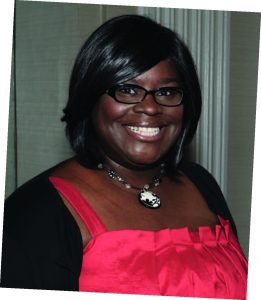
Editor’s Note: Retta, aka Marietta Sangai Sirleaf, was born in Newark and grew up in Middlesex and Monmouth Counties. She graduated from Duke in 1992 and launched her stand-up career in Raleigh, North Carolina. She made her TV debut on a 1997 episode of Moesha and her movie debut in the 2002 cult classic Slackers. In addition to Parks and Rec and Good Girls, Retta also had a recurring role on Girlfriends’ Guide to Divorce with FOE (Friend of Edge) Lisa Edelstein.
Thanks to a bumper crop of home hydroponic and aeroponic products, more and more New Jerseyans are growing their own.
Around the time I returned home to New Jersey from a COVID-shortened “vacation” last March, I and much of the nation experienced pantry panic—an undiagnosed anxiety related to food sourcing and hygiene. A trip to the grocery store, to feed our family, was fraught with fears of air-borne disease droplets lurking in the meat section and vegetable aisles. I had no idea what was safe and germ-free. Once home, this anxiety spurred me to clear all our window boxes and plant seeds of radishes, chervil, basil, parsley and lettuces. I also joined a local farm CSA (that’s short for Community-Support Agriculture) that weekly provided a seasonal assortment of lettuce, tomatoes, zucchini, potatoes, peppers and squash, all grown within five miles of our suburban house.
With the pandemic wave rising in the autumn of 2020, the cold dark months of winter bearing down, my home and CSA-grown supply of fresh vegetables ending and no idea where our place would be in the vaccine line, I began looking at options for how to provide a safe and local food source. I already had a grow light in the basement, so why not try hydroponics?
Like Zoom, Netflix, Amazon, Peloton and Pfizer, hydroponics is a pandemic growth industry and, with 20-20 hindsight, might have been a prescient investment in 2020. If you google hydroponics, over 67 million results pop up. Products ranging from $99 Kohl’s and $73 Wayfair contraptions to state-of-the-art growing units costing in the thousands, promise a pandemic-free pantry, with fresh tomatoes, cucumbers and lettuce. Producing this year-round, home-grown salad without having to venture into a potentially germ-ridden store, allows the indoor farmer to become the ultimate locavore.
Indeed, hydroponics lowers your carbon footprint: the produce is energy-efficient, wasting no gas for shipping from California or Peru or driving to the local green grocer. And in spite of the initial dollar outlay for a hydroponic growing pod, home-grown food, over time, is likely to be less expensive, healthier, fresher and more sustainable since you are employing only the water solution and the electricity for a grow-light, water pump and filter. The age-old parental advice of “eat your greens” might actually eat up less green… and there are many businesses eager to help you grow your own.
 Tom Corvo, owner of Shore Grow Hydro, a three-year-old hydro-ponics retail store in Ocean, says there are many consider-ations that determine what sort of home-growing unit to purchase: Do you have the space, time Shore Grow Hydro and budget? Generally the lights are the most expensive purchase. One customer spent $50,000 to set up two rooms with hydroponics. Or you could invest in a simpler set-up of a lettuce raft floating in a 2 x 4-foot tray on legs with a grow light for under $500. The store smartly offers support: the last Thursday in every month, Shore Grow runs classes—from Hydro 101 for seed starting and fruiting to more advanced 201 classes for propagation, pest control and the finer points of automation.
Tom Corvo, owner of Shore Grow Hydro, a three-year-old hydro-ponics retail store in Ocean, says there are many consider-ations that determine what sort of home-growing unit to purchase: Do you have the space, time Shore Grow Hydro and budget? Generally the lights are the most expensive purchase. One customer spent $50,000 to set up two rooms with hydroponics. Or you could invest in a simpler set-up of a lettuce raft floating in a 2 x 4-foot tray on legs with a grow light for under $500. The store smartly offers support: the last Thursday in every month, Shore Grow runs classes—from Hydro 101 for seed starting and fruiting to more advanced 201 classes for propagation, pest control and the finer points of automation.
I admit my mind glazes over when I learn that there are finer maintenance details to hydroponics than I’m used to (compared to outdoor gardening), such as checking the water for 5.5-6.5 PH and adjusting it, changing water every two to three weeks, choosing a nutrient (organic or not). Yet, Corvo says that business is steady to good and expects an even greater up-tick in home-growing hydroponics, especially with marijuana now legal in the Garden State.
 On the opposite coast, there’s California-based Hamama, a micro-green growing system that pops up on my Facebook feed every day. The ads of this e-commerce hydroponics company are appealing and tempting. What intrigues me is the promise of healthful microgreens that grow quickly, easily and don’t take up a lot of space or energy—as well as no need for a water pump or filter. (So technically is this hydroponic?) Better yet, the company’s “starter kit” doesn’t cost a lot of lettuce: $35 plus free shipping. Costs can mount if you go all-in and purchase a “grow shelf” that accommodates six grow trays. I spoke with Camille Richman at Hamama, who reports that orders have increased during the pandemic and that their top-seller is the Super Salad Mix Seed Quilt, a growing medium that contains broccoli, kale, arugula, kohlrabi, cabbage and cauliflower seeds. But the jury is out: Amazon customers either loved or hated the product—the seed strips worked for some and didn’t deliver salad for others.
On the opposite coast, there’s California-based Hamama, a micro-green growing system that pops up on my Facebook feed every day. The ads of this e-commerce hydroponics company are appealing and tempting. What intrigues me is the promise of healthful microgreens that grow quickly, easily and don’t take up a lot of space or energy—as well as no need for a water pump or filter. (So technically is this hydroponic?) Better yet, the company’s “starter kit” doesn’t cost a lot of lettuce: $35 plus free shipping. Costs can mount if you go all-in and purchase a “grow shelf” that accommodates six grow trays. I spoke with Camille Richman at Hamama, who reports that orders have increased during the pandemic and that their top-seller is the Super Salad Mix Seed Quilt, a growing medium that contains broccoli, kale, arugula, kohlrabi, cabbage and cauliflower seeds. But the jury is out: Amazon customers either loved or hated the product—the seed strips worked for some and didn’t deliver salad for others.
 By now, you may have surmised that I’m in favor of low-maintenance systems. I gravitate to easy-to-use and safe products. So I also gravitated to a hydroponics off-shoot called aeroponics. Aerofarms Aeroponics is a growing system that combines aeration and nutrient misting that encourages faster plant growth. Newark is home to Aerofarms, a “data-driven” indoor vertical growing farm and company that has been in the news the last few years. This New Jersey “home-grown” business enjoys several partnerships around the state, nationally and globally. The company, which claims its growing systems need 95% less water than outdoor farms, has been selling its lettuces, herbs and microgreens to restaurants ranging from Red Rooster to Momofuku, as well as retail grocery chains including Whole Foods under the brand Dream Greens. Aerofarms also professes to be 390 times more productive per square foot than traditional agriculture. Privately owned, the company enjoys financial partnerships with Goldman Sachs, IKEA and Dubai Holdings. Now Aerofarms is building the world’s largest aeroponic farm—90,000 square feet—in Abu Dhabi.
By now, you may have surmised that I’m in favor of low-maintenance systems. I gravitate to easy-to-use and safe products. So I also gravitated to a hydroponics off-shoot called aeroponics. Aerofarms Aeroponics is a growing system that combines aeration and nutrient misting that encourages faster plant growth. Newark is home to Aerofarms, a “data-driven” indoor vertical growing farm and company that has been in the news the last few years. This New Jersey “home-grown” business enjoys several partnerships around the state, nationally and globally. The company, which claims its growing systems need 95% less water than outdoor farms, has been selling its lettuces, herbs and microgreens to restaurants ranging from Red Rooster to Momofuku, as well as retail grocery chains including Whole Foods under the brand Dream Greens. Aerofarms also professes to be 390 times more productive per square foot than traditional agriculture. Privately owned, the company enjoys financial partnerships with Goldman Sachs, IKEA and Dubai Holdings. Now Aerofarms is building the world’s largest aeroponic farm—90,000 square feet—in Abu Dhabi.
On a much smaller, home-growing scale, Karen Campi sells the aeroponic Tower Garden to homes in New Jersey and partners with local schools in Summit and Bernardsville. While hydroponics start crops from seed, aeroponics functions with starter plants. Campi  says the vertical growing units—an outdoor one ($620) and an indoor version ($970) with LED grow-lights—are selling so well she can’t keep them in stock. While Tower Garden offers a seed starting kit for $29, a first farming foray might be better served with $2 plant seedlings. The indoor tower can house up to 16 microgreens and 16 full greens at one time. Campi says that the plants last up to three or four months and recommends harvesting lettuce from the outside. Her enterprising college-age son Joe has started a Tower Garden Cleaning and Set-up business to help her clients maintain their towers. As a multi-tasker with a half-dozen projects in the works, I don’t want to think about upkeep. So perhaps Joe’s $120 maintenance fee per season for one indoor model, though pricy, could be worth it.
says the vertical growing units—an outdoor one ($620) and an indoor version ($970) with LED grow-lights—are selling so well she can’t keep them in stock. While Tower Garden offers a seed starting kit for $29, a first farming foray might be better served with $2 plant seedlings. The indoor tower can house up to 16 microgreens and 16 full greens at one time. Campi says that the plants last up to three or four months and recommends harvesting lettuce from the outside. Her enterprising college-age son Joe has started a Tower Garden Cleaning and Set-up business to help her clients maintain their towers. As a multi-tasker with a half-dozen projects in the works, I don’t want to think about upkeep. So perhaps Joe’s $120 maintenance fee per season for one indoor model, though pricy, could be worth it.
If you choose to bypass Joe’s services, Beyond Organics Growers supplies the plant seedlings for Tower Garden. Theresa Reid, owner of the five-year-old company, says that the original business model was supplying restaurants and a few retail customers. After COVID, the restaurant end of their business nearly dried up, but the number of home-growing customers grew. “The retail business more than made up the difference,” she says.
During the winter months, Beyond Organics has been supplying Tower Garden customers with a wide variety of lettuces and herbs—romaine, arugula and spring mix being top sellers. Now the company is taking additional growing orders from tower owners (as well as garden patch growers) for its organic spring crops, such as tomatoes and cucumbers, which are incubated in a rock-wall greenhouse with radiant heated floors.
Be it hydro or aero, the mere act of watching something grow during the stark cold months—and then harvesting it—is emotionally and nutritionally enriching. In the chaos of 2020, high-tech home-growing presented a wonderful opportunity. The question is, how many of us will stick with it—and how many more will double down when winter comes again in 2021? As vaccines tame the pandemic and marijuana becomes legal, it will be interesting to see how this business evolves this year and beyond.
Rediscovering the slow cooker in COVID times.
The irresistible appeal of a slow cooker is its convenience and simplicity. Turn it on, and it cooks dinner while you do other things. You have no pot to watch. It doesn’t burn or spill over. Just set it and let it do its work. Next thing you know, your kitchen smells heavenly, and you feel like your personal chef did all the work. One profound effect of the current pandemic stay-at-home culture is that we are doing more home cooking. In and of itself, this can be a good thing. However, it has also given rise to stress eating and weight gain. Remember the “Freshman 15,” the weight-gain trend on college campuses? The pandemic gives us a new trend being called “The COVID 19.” Two ways to counter unwanted weight gain are to stop eating junk food, and keeping lots of healthy foods on hand, especially plant-based whole food meals made with beans, whole grains, and vegetables.
The growing interest in slow cooking has come at a time when more and more people are focused generally on better health and healthy eating, and specifically on the benefits of a plant-based diet. When you factor in a widening awareness of world cuisine, we may well be looking at a game-changing culinary moment. This confluence of trends encouraged me to revisit a book I wrote nine years ago, Fresh from the Vegan Slow Cooker. In 2020, I authored a new book that features more than 225 recipes using only plant-based ingredients—with chapters on everything from breakfast to main courses, appetizers to desserts, and condiments and beverages. These are some of my favorites…
Root Vegetable Bisque with Herbs de Provence
6 to 8 hours
Traditional bisques are often thickened with rice, so I’ve added some to this recipe. The soup is puréed after cooking and then returned to the pot to serve. If you prefer a chunky rather than creamy soup, you can omit the puréeing step. Just don’t call it a bisque!
1 medium-size yellow onion, chopped
3 garlic cloves, chopped
2 carrots, coarsely chopped
2 medium-size parsnips, peeled and coarsely
chopped
1 small turnip, peeled and diced
1 medium-size Yukon Gold potato, peeled
and diced
1/3 cup (63 g) raw brown rice
1 (14-ounce, or 395 g) can diced tomatoes, drained 4 cups (960 ml) vegetable broth
2 teaspoons dried herbes de Provence
Salt and freshly ground black pepper
2 tablespoons (8 g) chopped fresh flat-leaf parsley,
for garnish
 1. Combine the onion and garlic in the slow cooker. Add the carrots, parsnips, turnip, potato, and rice. Stir in the tomatoes, broth, herbes de Provence, and salt and pepper to taste. Cover and cook on Low until the vegetables are tender, 6 to 8 hours.
1. Combine the onion and garlic in the slow cooker. Add the carrots, parsnips, turnip, potato, and rice. Stir in the tomatoes, broth, herbes de Provence, and salt and pepper to taste. Cover and cook on Low until the vegetables are tender, 6 to 8 hours.
2. Use an immersion blender to puree the soup right in the pot or transfer the soup, in batches, to a high-powered blender or food processor and puree until smooth, then return to the pot. Taste and adjust the seasonings, if needed. Serve hot, sprinkled with the parsley.
 Holy Mole Red Bean Chili
Holy Mole Red Bean Chili
6 to 8 hours
The rich depth of flavor from the mole sauce elevates a humble chili to new heights. I especially like the addition of chopped seitan in this chili, but you may substitute Soy Curls, tempeh, or jackfruit, if you prefer.
1 large yellow onion, chopped
4 garlic cloves, minced
1/2 small green bell pepper, seeded and chopped 3 tablespoons (48 g) tomato paste
2 tablespoons (10 g) unsweetened cocoa powder 2 tablespoons (32 g) almond butter
2 to 3 tablespoons (15 to 22.5 g) chili powder
1 tablespoon (17 g) minced chipotle chiles in adobo 1/2 teaspoon ground cinnamon
1 (14.5-ounce, or 410 g) can diced fire-roasted
tomatoes, drained and juices reserved
1 (14-ounce, or 395 g) can crushed tomatoes 3 cups (768 g) cooked dark red kidney beans
or 2 (15-ounce, or 425 g) cans beans, rinsed and drained
8 ounces (225 g) seitan, chopped
2 cups (480 ml) water
1 teaspoon salt
1/4 teaspoon freshly ground black pepper
Diced avocado, pepitas (green pumpkin seeds)
chopped scallions, and/or chopped fresh cilantro, for garnish
1. In the slow cooker combine the onion, garlic, and bell pepper. Stir in the tomato paste, cocoa, almond butter, chili powder, chipotles, cinnamon, and the juices from the diced tomatoes, stirring to blend.
2. Stir in the diced tomatoes, crushed tomatoes, beans, seitan, water, salt, and pepper. Cover and cook on Low for 6 to 8 hours.
3. Taste and adjust the seasonings, if needed. Serve hot, garnished with desired toppings.
A World of Beans
Because bean cooking was the intended use of the first slow cookers, it almost goes without saying that beans are a natural fit for the slow-cooking method. While many of us enjoy cooking a variety of different beans, it’s a safe bet that most of us have barely scratched the surface in terms of what types are available. Believe it or not, there are more than 13,000 different beans and legumes in the world. That’s a lot of beans!
Because beans take longer to cook than most vegetables, I prefer to use beans that I have already cooked in most of my recipes to avoid overcooking the vegetables. Another reason for using precooked beans in recipes is that it allows me to drain off the cooking liquid after cooking beans, making them more digestible. Cooking beans from the dried state in the slow cooker is both easy and economical. Here are some of the basics…
● A convenient way to prepare dried beans to use in recipes is to cook the beans in your slow cooker overnight on Low. They will be done by morning.
● A small piece of kombu sea vegetable added to the pot while the beans cook will help tenderize the beans while adding flavor and nutrients.
● Dried herbs should be added to beans during the final thirty minutes of cooking time. However, it is best to add fresh herbs after the beans are cooked for the best flavor.
● To keep cooked beans from drying out, cool them in their cooking liquid. For improved digestibility, be sure to drain the bean cooking liquid first before using the cooked beans in a recipe.
● Consider cooking a large amount of beans, portion them into airtight containers, and store them in the refrigerator for up to one week or in the freezer for up to six months.
Artichoke Risotto
2 hours
In order to achieve the right texture and flavor, this risotto requires a few minutes of skillet time before combining in the slow cooker. It’s not a bad trade-off when compared to all of the hands-on stirring involved in making conventional risotto. Using nutritional yeast makes this soy-free, although you can substitute a soy-free vegan Parmesan instead.
1/4 cup (60 ml) water, or 2 teaspoons olive oil 1 small yellow onion or 2 shallots, minced
1/4 cup (60 ml) dry white wine
1 1/4 cups (237.5 g) Arborio rice
3 1/2 cups (840 ml) vegetable broth, plus more
if needed
2 teaspoons chopped fresh thyme leaves,
or 1 teaspoon dried thyme
1/2 teaspoon salt
2 cups (600 g) canned or frozen artichoke hearts,
thawed, chopped
2 tablespoons (7.5 g) nutritional yeast, or 1/4 cup
(33.5 g) Almond Parmesan
2 teaspoons fresh lemon juice
Freshly ground black pepper
1/4 cup (30 g) chopped toasted walnuts, for
garnish
2 tablespoons (6 g) snipped fresh chives, for garnish;
1. Heat the water or oil in a medium-size skillet over medium-high heat. Add the onion and sauté until softened, about 5 minutes. Stir in the wine and cook for 30 seconds, then add the rice and cook, stirring, for 2 minutes.
2. Transfer the rice mixture to the slow cooker. Add the broth, thyme, and salt, cover, and cook on High until all of the liquid is absorbed and the rice is just tender, about 2 hours.
3. Stir in the artichokes, nutritional yeast, lemon juice, and pepper to taste. Taste and adjust the seasonings, if needed. If the mixture is too dry, stir in a little more hot broth as needed.
4. Serve hot, spooned into shallow bowls. Sprinkle each serving with the toasted walnuts and chives.
Why Slow-Cook?
• It’s a convenient way to prepare healthy home-cooked meals.
• It allows you to cook and serve in the same vessel, so it saves on cleanup time.
• It can have dinner ready and waiting for you at the end of the day.
• The slow, gentle cooking adds depth of flavor to foods.
• It keeps the kitchen cool on hot days.
• It’s an ideal way to cook beans and seitan from scratch.
• It doubles as a chafing dish or hot punch bowl at parties.
• It’s economical because it uses less energy than oven cooking and makes great leftovers.
• It can be used as a mini-oven to slow-bake cakes, casseroles, potatoes, and more
• It frees up stovetop burners when cooking for parties or for a crowd on holidays.
 Rustic Potpie Topped with Chive Biscuits
Rustic Potpie Topped with Chive Biscuits
5 to 7 hours
This rustic potpie features a top crust of tender drop biscuits that cook right in the slow cooker. The steam heat produces a soft and tender biscuit topping. If you prefer a drier texture to the biscuits, let the cooked potpie sit uncovered for about 10 minutes before serving. To make this gluten-free, use diced tempeh or extra-firm tofu instead of seitan and use a gluten-free flour blend. For soy-free, omit the soy sauce and use Soy-Free Sauce, or coconut aminos, or add some soy-free vegetable broth base or additional salt, and a soy-free plant milk.
2 tablespoons (30 ml) plus 2 teaspoons olive oil 1 medium-size yellow onion, minced
2 large carrots, peeled and minced
2 tablespoons (32 g) tomato paste
1 teaspoon dried thyme
1/2 teaspoon dried marjoram
1 cup (124 g) plus 3 tablespoons (23.25 g)
all-purpose flour
3 tablespoons (45 ml) dry red wine
1 tablespoon (15 ml) soy sauce
1 cup (240 ml) vegetable broth
2 medium-size Yukon Gold potatoes, peeled and
cut into 1/2-inch (1 cm) dice
8 ounces (225 g) cremini mushrooms, coarsely
chopped
8 ounces (225 g) seitan, cut into 1/2-inch (1 cm) dice Salt and freshly ground black pepper
3/4 cup (97.5 g) frozen green peas, thawed
11/2 teaspoons baking powder
1 tablespoon (0.2 g) dried or (3 g) snipped fresh chives 1/2 cup (120 ml) plain unsweetened plant milk
1. Heat 2 teaspoons of oil in a large skillet over medium-high heat. Add the onion and carrots and sauté for 5 minutes. Stir in the tomato paste, thyme, and marjoram and cook for 1 minute longer. Sprinkle on 3 tablespoons (23.25 g) of flour and cook for 30 seconds. Add the wine, soy sauce, and broth, stirring after each addition.
2. Transfer the onion mixture to the slow cooker. Add the potatoes, mushrooms, seitan, 1/2 teaspoon of salt, and 1/4 teaspoon of pepper. Cover and cook on Low until the vegetables are tender, 4 to 6 hours. Taste and adjust the seasonings, if needed, then stir in the green peas.
3. In a large bowl, combine the remaining 1 cup (124 g) of flour, the baking powder, chives, and 1/2 teaspoon salt. Quickly stir in the plant milk and the remaining 2 tablespoons (30 ml) of oil until just blended. Drop the biscuit mixture by large spoonfuls onto the surface of the simmering stew. Turn the heat setting to High, cover, and cook until the dough is cooked through, about 1 hour longer.
4. Serve within 15 minutes after the biscuit dough has finished cooking.
Variations: Instead of the seitan, use cooked chickpeas or chopped tempeh. You could also use sweet potatoes instead of the white potatoes, or add turnips in addition to the carrots, and so on. Different herbs could be used in the biscuits—instead of chives, try dill and a little dried savory, if you have some.
Happy Half-Century
The Rival Crock-Pot turns 50 this year. In 1971, Rival bought the “original” consumer electric slow cooker, the Naxon Beanery, which was originally developed for bean cooking. The Crock-Pot was marketed to working women as a way to make a home-cooked meal while they were at work, and they quickly put it to use in preparing pot roasts and other meat-centric dishes. A phenomenal hit at the time, the Crock-Pot fad faded, only to enjoy a resurgence some 30 years later. Since the early ’70s, more than 80 million slow cookers have been sold.
 Coconut Rice Pudding
Coconut Rice Pudding
with Mango
1 1/2 to 2 hours
A favorite dessert in Thai restaurants, rice pudding with fresh mango is easy to make at home in your slow cooker. If you prefer a sweeter pudding, add up to 1/4 cup (50 g) extra sugar.
1 1/2 cups (300 g) raw jasmine rice
1/2 cup (100 g) granulated natural sugar,
or more to taste
1/4 teaspoon salt
2 (14-ounce, or 395 g) cans unsweetened
coconut milk
1/2 cup (120 ml) unsweetened plant milk, plus
more if needed
1 teaspoon coconut extract
1 teaspoon pure vanilla extract
1 large ripe mango, peeled, pitted, and chopped
1. Lightly coat the slow cooker insert with vegan butter or nonstick cooking spray. Combine the rice, sugar, and salt in the cooker. In a saucepan or the microwave, heat the coconut milk and plant milk just to boiling. Slowly add the heated milks to the slow cooker, stirring to dissolve the sugar. Cover and cook on High until the rice is tender, about 1 1/2 hours.
2. Turn off the slow cooker and stir in the coconut and vanilla extracts. Allow to cool, uncovered, for 10 minutes, then stir in the mango. To help thicken the pudding, stir it gently to let it absorb any remaining liquid; it will continue to thicken as it cools. If the pudding is too thick, stir in a little more plant milk until it’s the consistency you like. The pudding can be served warm, at room temperature, or chilled. To serve chilled, spoon the pudding into dessert glasses, cover, and refrigerate until cold.
A slow cooker is an easy way to prepare nourishing and comforting dishes such as chili, casseroles, stews, and hearty soups made with beans, grains, and vegetables. Preparing food in a slow cooker retains all the nutrients and condenses the delicious flavors. And because slow-cooked dishes can be made without oil, they are low in fat and contain no cholesterol, making them ideal for these challenging times when we may be prone to eating more. EDGE
Editor’s Note:
Robin Robertson is a veteran restaurant chef, cooking teacher and columnist. She has authored numerous cookbooks, including The Plant-Based Slow Cooker ($27.99 Harvard Common Press) and best-sellers Fresh from the Vegan Slow Cooker, Vegan Planet, Vegan on the Cheap, and Quick-Fix Vegan. For more info visit her web site robinrobertson.com.
How have you been coping with Coronavirus?
I’m a New Yorker, so we stayed in New York City. I feel very safe in New York because, no matter what people say about New York, I’m sorry but it’s a great city and New Yorkers really do watch out for each other—even though it may not look like it. Eventually I was able to go upstate to an area where there aren’t many people. But, of course, our hearts were here with the frontline workers and with all the wonderful citizens who have been so ill. In a way, I feel like the whole world has been given a pause to reflect on where we’re going, especially in terms of health…but also with climate change. If we can change our behavior that quickly for COVID, we can change our behavior that quickly to protect the planet and each other. I hope that we as a whole world use this opportunity to come together more. And I hope our country is part of that.
Do you think theater will bounce back?
I think it will change and that’s not necessarily bad. It will become less expensive, less exclusive, maybe more the people’s theatre, as it was in Shakespeare’s day… I don’t have a crystal ball, but I think that maybe we’ll go back to a different phase. Broadway now has so many musicals and very, very big, big shows and they’re great—I have great respect and admiration for all that’s involved—but theater used to be a more intimate experience for the audience, a more specific experience, perhaps. I believe the theater will carry on forever because it’s the people’s theater really in the end. We tell stories that illuminate the human heart. And there will always be an audience for that, if we have to do them standing outside or on a bus or who knows what. But I worry about my friends who are theater actors and are so used to working non-stop. I’m very worried about them.
How did appearing on (the Netflix French-language series) Call My Agent in 2020 come about?
I had been a fan since I was told about it by a French friend. I never dreamed that I would be in it. It was probably a secret wish, but I never mentioned it to anyone, except maybe my husband. And so I was very surprised to get this script when I was shooting a film in Nova Scotia, with an offer and a script about me. It was the first time in my life, without reading the script I just said Yes right away.
How do you look back on playing Ripley in Alien…and that so many people look to her as a role model?
All of us on Alien are very pleased that the film still resonates for people. Ripley was written basically as a character, a kind of “every person,” and it was unusual then, especially not to have a woman go, “Oh, my goodness!” The writers and the producers and (director) Ridley Scott did not want that, and neither did I. I think now we’re so far away from that in terms of women’s strength and women’s situation. We have a long way to go, but it’s changing so rapidly.
Editor’s Note: This Q&A was conducted by Jason Adams of The Interview People. Jason interviewed a number of celebrities in 2020, including Elle Fanning, Javier Bardem and Vanessa Kirby, who plays Princess Ann on the current season of The Queen. Sigourney Weaver has completed filming for Avatar II and III, which are slated for release late next year. Season 4 of Call My Agent (Dix pour Cent) will be streaming on Netflix later in 2021.








